










JULY 2023 – JUNE 2024
Leadership
Donald R. Webster, Ph.D., PE, F.ASCE, SF.ASLO
Karen and John Huff School Chair
Susan E. Burns, Ph.D., P.E., F.ASCE
Associate Chair for Finance and Administration
Dwight H. Evans Professor
Lauren Stewart, Ph.D., P.E.
Associate Chair for Graduate Programs Director, Structural Engineering and Materials Laboratory Williams Family Associate Professor
Kevin Haas, Ph.D.
Associate Chair for Undergraduate Programs
Adjo A. Amekudzi-Kennedy, Ph.D., F.ASCE, NAC
Associate Chair for Global Engineering Leadership and Entrepreneurship
Frederick Law Olmsted Professor
John E. Taylor, Ph.D.
Associate Chair for Faculty Development and Research Innovation Frederick Law Olmsted Professor
Patricia D. White, J.D. Director of Development patricia.white@ce.gatech.edu P / 404.894.7289
School of Civil and Environmental Engineering at Georgia Tech 790 Atlantic Drive N.W. Atlanta, Georgia 30332-0355 communications@ce.gatech.edu P / 404.894.2201 ce.gatech.edu
Communications Team
Melissa Fralick
Communications Manager
Michael Hunter Communications Officer

Iam delighted to share with you the remarkable progress we’ve made over the past academic year in the School of Civil and Environmental Engineering. We reached an important new milestone in the evolution of our undergraduate curriculum, increased the quality of life for our graduate assistants, and celebrated the achievements of our students and faculty in the 2023-2024 academic year.
Following several years of work from our dedicated faculty leadership, we are excited to announce the approval of four courses that will now anchor the undergraduate experience. Thanks to multi-year funding from the National Science Foundation and the Kern Entrepreneurial Engineering Network, we were able to develop these courses to engage our students early and equip them with the computational, collaborative, and professional skills they will need to flourish in our rapidly evolving workforce.
In addition to enriching our curriculum, we are pleased to announce that we have increased stipends for graduate students. This helps our current students keep pace with the rising cost of living and ensures that we can continue to attract and support the brightest minds in civil and environmental engineering moving forward.
You’ll also see that our students' achievements extend beyond the classroom, as evidenced by their outstanding performance in various competitions. Their dedication, creativity, and teamwork demonstrate the exceptional caliber of talent nurtured within our community by our engaged faculty.
In closing, I invite you to explore the following pages to learn more about the exciting developments and achievements happening here at the School of Civil and Environmental Engineering. None of this would be possible without the generous support of friends like you, and for that, we are deeply grateful.
Thank you for your continued support and dedication to our school's mission. Together, we are shaping the future of civil and environmental engineering.

and John Huff School Chair and Professor
2
3
Degrees Offered
2
Bachelor's Degrees:
• Civil Engineering
• Environmental Engineering
1
Minor:
• Global Engineering Leadership Concentrations:
• Construction and Infrastructure Systems
6
Master's Degrees:
• Bioengineering
• Civil Engineering
• Computational Science and Engineering
• Engineering Science and Mechanics
• Environmental Engineering
• Dual Degree - M.S. Civil Engineering & City and Regional Planning
2023-2024 Academic Year:
Enrollment: Undergraduates: 614
Graduates: 426
6
Doctoral Degrees:
• Bioengineering
• Civil Engineering
• Computational Science and Engineering
• Engineering Science and Mechanics
• Environmental Engineering
• Ocean Science & Engineering
Faculty: Endowed Positions: 26
Total Faculty: 60
Entrepreneurship

By Michael Hunter
Two teams of students were awarded $5,000 each in the fourth annual Entrepreneurial Impact Competition: Civil and Environmental Engineering’s answer to reality show “Shark Tank.”
The competition’s judges were impressed by the teams’ concepts of a trucking industry safety app—based on GPS location, real-time data and previous crash data—and a campus food delivery app for and implemented by Tech students.
Students were invited to submit concepts in the 2023 fall semester, and four finalists were selected to compete in the April 1 competition.
Each of the four teams was given five minutes to explain their concept and then field 10 minutes of indepth questioning from the panel of judges. After the presentations, the judges adjourned to deliberate and select the winner in each of the two categories. The Higginbotham Entrepreneurship Award recognizes a more developed project, which is closer to being launched in the marketplace, and the Zeitlin Innovation Award recognizes creativity in a project at any stage of its development.
The team Himalayan Yetis, comprised of Sashank Rana and Aarosh Dahal, won the Higginbotham prize for their project, Mitho-Mitho.
Mitho-Mitho is a web and mobile application designed to facilitate the delivery of food from campus restaurants at the student center and the Tech Square area by and to Georgia Tech students. The service
would utilize students’ Buzzcards for identification and payment purposes. In return for their delivery service, students could earn rewards and dining dollars.
Team captain Sashank Rana explained that he and Dahal realized while studying that it would take an hour to walk to a nearby restaurant, eat and return to the Mason building. Rana said they created their concept to help students be more efficient with their time.
“For example, I work in Coda, but my classes are here in Mason,” Rana said. “While coming here, Tech Square is in between. If I get a notification saying somebody needs some food from Moe’s, I can get it from Tech Square and give it to somebody at Mason.
“So, it's a win for me, the restaurant, and also the student who ordered.”
In response to a judge’s question of how they would compete with more established food delivery services, Rana replied that services like Uber Eats and Doordash, “don’t go inside the campus. We have to go all the way out. Students, they can roam around the campus, and that's why it’s easier.”
The team plans to launch their app in the upcoming fall semester and will utilize their winnings to pay for app development, marketing and also the design of tamper-proof packaging.
“We’re not only delivering food, but also peace of mind of the students, to the students, and for the students,” Rana summed up.
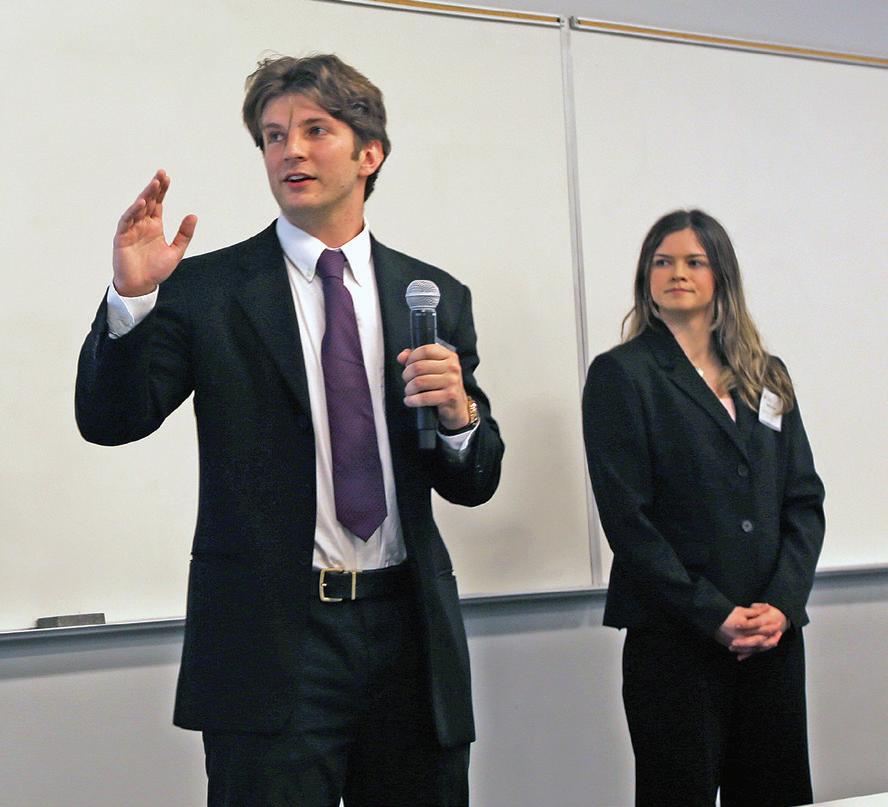
According to Principal Academic Professional Lisa Rosenstein, a member of the judging panel, the judges “responded to the specific need for this service on the GT campus and especially to the detailed implementation plan.”
Transportation Analytic Solution (TAS), the team of Reid Cabe and Madeleine Sanders, won the 2024 Zeitlin Innovation Award.
TAS’ concept is to address the cost of trucking industry accidents by creating a smartphone app that combines GPS, real-time traffic, and historical crash data to alert truckers of high-risk areas, potentially reducing accidents.
According to a 2018 study by the Federal Motor Carrier Safety Association, trucking accidents cost the industry $99 billion in that year alone. The trucking industry in the U.S. spends 13 cents per mile driven in insurance costs. TAS projects usage of its application could save the industry 3 cents a mile, for $9 billion in savings.
“Based on that, we want to market ourselves to insurance agencies which would then go to their clients and give them a discount for using the app,” explained Cabe. “The truckers make money because they get a discount, and then the insurance company would also make money because they will have to pay for less crashes and we will also get a part of that, too.”
The team, which based its model on crash data
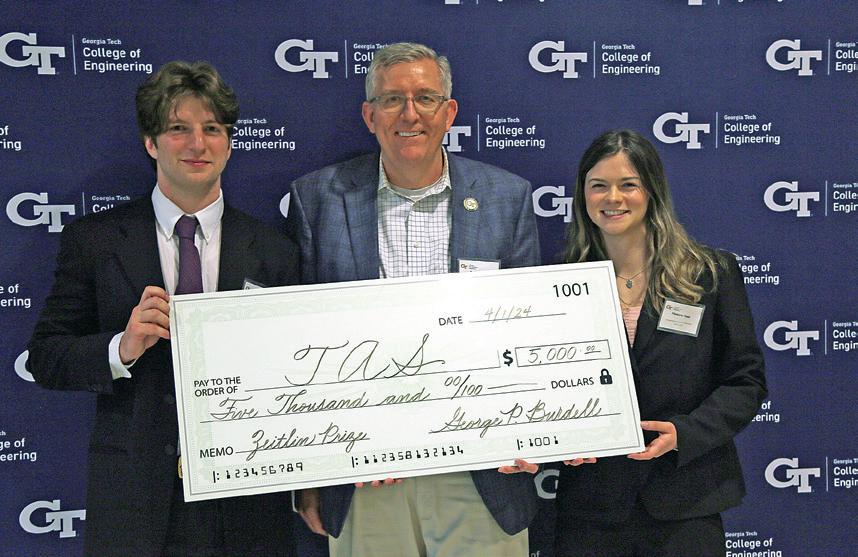

from the state of Georgia, also has data from 34 other states. TAS hopes to use the money from the Zeitlin award to “actually make this idea a reality, creating the software,” according to Sanders, who is in charge of data science for the team. “Then from there, running, pilot-testing, and seeing if our app actually works to change the driver's behavior,” she concluded.
“Driver behavior accounts for over 95% of crashes as opposed to the vehicle failing,” Cabe explained. “Almost all crashes are caused by driver behavior. The basic idea behind the app is, if we can change driver behavior, we could prevent these crashes.”
According to Rosenstein, the judges were impressed by the detailed problem description and a new application for data science. “We also appreciated the large potential market for this idea if access to the data were expanded to the general public,” Rosenstein said.
The Entrepreneurial Impact Competition was established in 2021 to encourage a spirit of entrepreneurship in CEE students. The idea was led by Bill Higginbotham, CE 76, a serial entrepreneur and instructor who teaches Innovation and Entrepreneurship in CEE Systems. He endowed the Higginbotham Entrepreneurship Award, and Greg Zeitlin established the Zetilin Innovation Award in honor of his parents, Phyllis C. And Alan G. Zeitlin, CE 62. l

2
1. Reid Cabe, left, and Madeline Sanders accept the Zeitliin Award check from Karen and John Huff School Chair Don Webster.
2. Sashank Rana, left, and Aarosh Dahal, right, of Himalayan Yetis accept their $5,000 prize check with donor Bill Higginbotham, center.

By Melissa Fralick
Ateam from Georgia Tech won first place at an international student design competition for water quality infrastructure.
Civil and environmental engineering students Lucy Bricker, Makaela Edmonds, Isabella Hernandez, and Olivia Verret took the top prize at the annual Water Environment Federation’s Technical Exhibition and Conference (WEFTEC) “Water Environment” international student design competition in Chicago on Oct. 1, 2023. The team took home a $2,500 cash prize for their first-place win.
The team presented their CEE senior design project called “Duluth Middle School Green Stormwater Infrastructure,” which was a capstone project sponsored by Gwinnett County.
“We are all incredibly honored to have placed first in this competition, as it verified the quality of work that we did,” said Makaela Edmonds on behalf of the team. “All of the individuals judging the competition were working professionals in the industry, and it was extremely encouraging that they found our project to be impressive.
Earning this award gives each and every one of us the confidence that we are capable of succeeding in the CEE industry.”
For their project, the students worked with Gwinnett County to create a high-level concept design for best management practices to capture more stormwater around the Duluth Middle School campus. The team created five different green stormwater infrastructure designs that could be implemented, and a comprehensive outreach program to inform students and surrounding communities about the project.
The designs within their project included: a bus loop bioretention pond, an intercepting dry swale along a driveway, pervious pavement and mini-bio areas in a parking lot, and
planters intercepting roof gutters alongside school entrances.
In April, the students presented their project at the Georgia Association of Water Professionals (GAWP) student design competition and won first place. The team received a $5,500 travel stipend to sponsor the four students and their faculty advisor, Professor of the Practice Sharon Just, to attend the 2023 WEFTEC event in Chicago on Oct. 1.
WEFTEC is the world's largest annual water quality event. For this year’s WEFTEC student design competition, a total of 27 student teams competed in two award categories: water and wastewater.
Participating teams were the winners of design competitions in their state membership organizations. This year’s teams hailed from three international and 20 state and regional organizations.
Edmonds said the team members — two civil engineering majors and two environmental engineering majors — were all new to stormwater projects. During the capstone course, they worked through every aspect of the process, starting with a visit to the site and working all the way through the design cost estimations.
“It was fulfilling to take on a project in a new subject matter, and stay with it from start to finish,” Edmonds said.
Just, the team’s advisor and the instructor for the capstone design class, said she was impressed with her students’ dedication to the project and cohesion as a team.
Over the summer, they worked together after several team members graduated to reduce their 42-page capstone report down to 20 pages to submit to the WEFTEC competition.
“The team worked together in a very dedicated manner and put in the extra practice and work to make this happen. I am very proud of them,” Just said. l

By Michael Hunter
Georgia Tech students engineered a repeat of the school’s 2023 results, finishing in the top three positions in the Georgia Association of Water Professionals’ (GAWP) student design competition.
At the organization’s spring regional competition, environmental engineering teams from the capstone design course took first and second place, while a multidisciplinary team from the Engineers Without Borders student chapter won third place.
GAWP’s Student Design Competition promotes real-world design experience for students interested in pursuing education and a career in the water and wastewater field. The student teams submit a written report of their project and follow it up with an oral presentation before a panel of judges. Five spring Environmental capstone teams and one fall semester team from Tech entered the competition.
The “Mississippi Phosphates Superfund Leachate Treatment” project team comprised of Lauren Jackson, Shruti Sarkar, Zelda Siegel and Desirae Sievers was awarded first prize. The team won $5,500 for travel expenses for the four and their advisor, Professor of the Practice Sharon Just, to compete in the Water Environment Federation Technical Exhibition and Conference (WEFTEC) international student design competition in New Orleans this fall.
The team, along with their advisor, Just, completed a field visit to the Superfund site near Pascagoula, Miss., in February.
Second place was awarded to Molly Booker, Lauren Horst, and Dhanya Ravikrishnan for their project “Finding the Flint: Headwaters Nature Preserve.”
This team is also eligible to compete in the WEFTEC international student design competition this fall.

Third place went to a team from Tech’s Engineers Without Borders student chapter, GT Malawi, and their project, “Sanitation Solutions.” The members who presented were Grace Marek, Iman Al-Harthy, Priyali Bandla and Shreya Terala. Professor Hermann Fritz and Professor of the Practice Fred Meyer have served as the team’s advisors.
Just advised the first and second place winning teams and emphasized that each member of all the Tech teams spoke during their presentations. “The panel of judges, as well as the audience, were universally congratulatory to all of the teams, commenting on the quality of everyone’s presentation and noting how tight the competition was,” she said. l

By Michael Hunter
One of Civil and Environmental Engineering’s newest student organizations is creating community among students and gaining recognition from professionals in the concrete industry.
The student chapter of the American Concrete Institute (ACI) at Georgia Tech is a new student organization dedicated to providing future engineers opportunities for professional development related to the design and construction of concrete structures, as well as interaction with industry professionals involved in the organization’s Georgia Chapter.
In the short time since its launch in September 2023, the chapter has quickly flourished. Recently, it was recognized by the national organization as one of 100 outstanding student chapters out of over 300 around the world.
“This is an incredible feat for our young chapter, having only been officially chartered as an organization last semester,” said chapter president Connor Szeto, a Ph.D. student in the Structural Engineering, Mechanics and Materials group.
“What is a little surprising to me, is that we made it to 2023 without having a chapter,” said the group’s advisor, Professor of the Practice Fred Meyer.
Meyer credited two ACI Georgia members, Rob Weilacher and Jonathan Campbell, with planting the seed. Campbell and Weilacher work with structural engineering firm of Uzun + Case, which supports the School of Civil and Environmental Engineering as a Corporate Affiliate Partner.
“We have a very robust ACI Georgia chapter in this area,” Meyer said. “There was a great opportunity for Georgia Tech to have a student chapter that would then get to work along with the Georgia chapter.”
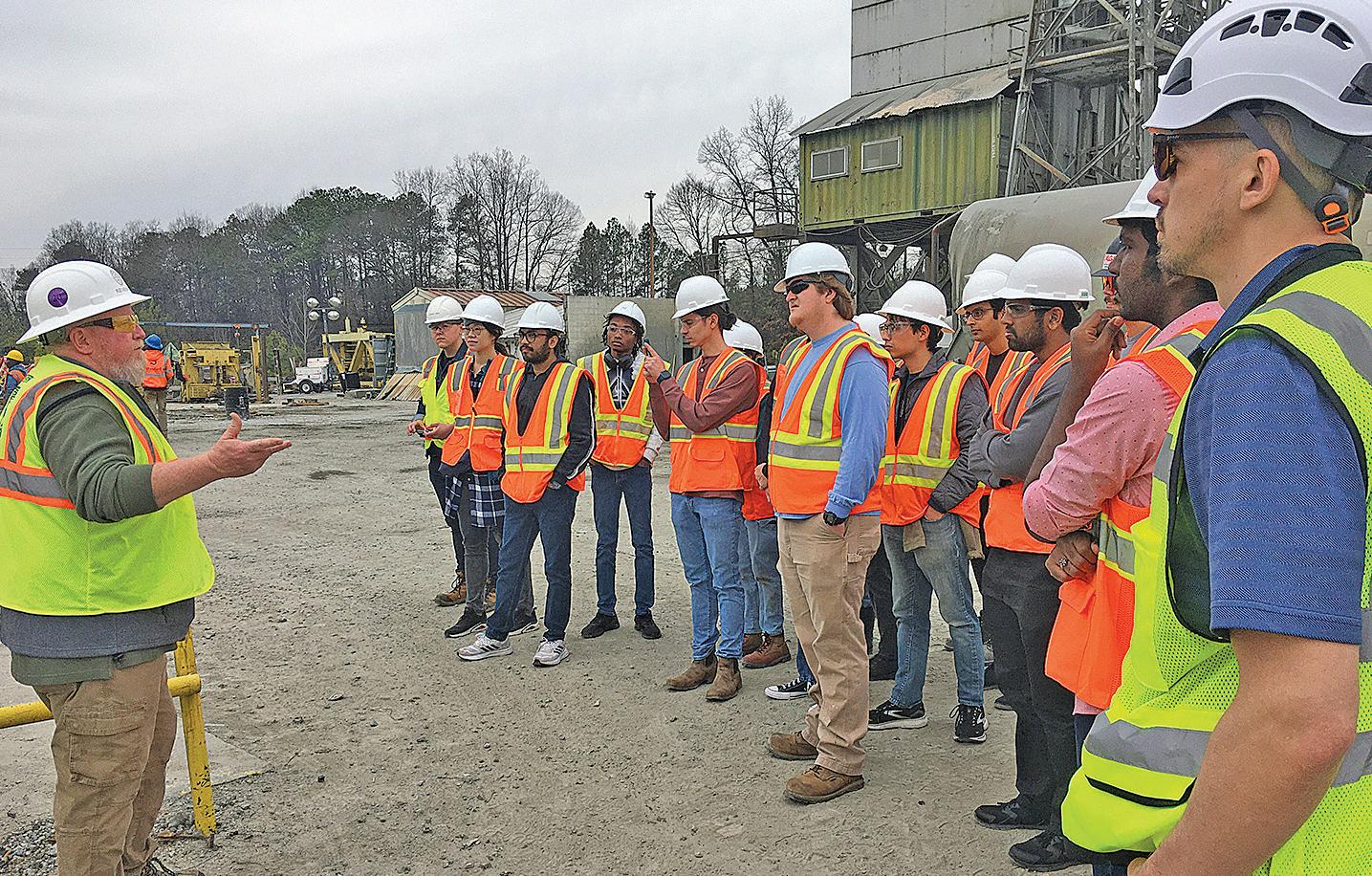
The student chapter, which currently has 23 members, has kept a robust meeting and event schedule, including a presentation on diagrid building and a field trip to a construction site at 1081 Juniper Street.
In 2024, the chapter has hosted a guest speaker and participated in a field trip to Standard Concrete Products on Feb. 16. Thirty students — a mix of chapter members and students from Meyer’s prestressed concrete course — went on a tour lead by plant manager Brett Martin and chief engineer and Tech alumnus Fletcher Smith, BS CE 02.
There chapter also visited the construction site of a 34-story apartment tower going up near the campus.


The chapter also participated in the ACI Concrete Convention in New Orleans March 24-28. A team of three undergraduate students competed in a mortar workability competition, in which teams mix mortar at the competition site and pour it into a mold made in the shape of the letters “ACI.” Flowability, mixture stability, and carbon neutrality are evaluated to determine the winner.
“I sat down with them initially, went through the design process and gave them some starting points, where they could do some trial mixes and figure out what would work,” Meyer said. “They’ve taken it and run with it on their own. The students we have here are fantastic, they’re self-starters.”
The ACI also offers funding to students in the form of fellowships and scholarships. Chapter president Szeto received the organization’s $5,000 Robert H. Kuhlman scholarship in 2023. In 2024, chapter vice president Bo Rider was awarded a fellowship and Tu-Nam Nguyen was awarded the Bernard Erlin Memorial Scholarship.
Members of the ACI student chapter can also earn a professional certification. In conjunction with the local ACI Georgia chapter, the Tech chapter is offering the
opportunity to get certified as a Level I technician.
“We have eight students interested,” said Meyer. “When they go through that, they get a certificate as a Level I concrete inspector, which means they can do a number of tests. That is nice for them to put on a resume when they go to look for a job one day.”
The American Concrete Institute at Georgia Tech has quickly forged connections between the student body and the concrete industry as well as illuminating career paths for future engineers.
“The ACI student chapter is an incredible way for students to get involved in all aspects of the concrete industry: engineering design, contracting and construction, and research and academia,” said chapter vice president Bo Rider, a master’s student in the Structural Engineering, Mechanics and Materials group.
Meyer is pleased with all that the ACI student chapter has been able to accomplish so far.
“We’re trying to really engage the chapter in all the things that we can and provide opportunities for our students. It’s been a lot of fun.” l

By Melissa Fralick
The EcoPeach Solutions team took home the prize for the best civil and environmental engineering project at the Spring 2024 Capstone Design Expo with their concept to grow fresh produce in space.
The team, advised by Professor of the Practice Sharon Just, is comprised of civil engineering students Jessica Brown and Pearl Dumbu, and environmental engineering students Ananya Kumar and Annabelle Sarkissian.
The team designed a modular, aeroponic crop system that could one day be used to provide fresh food to planetary habitats on the moon and Mars.
Their project was sponsored by Ralph Fritsche, a subject matter expert who recently retired from NASA.
EcoPeach Solutions was among 204 teams from 12 schools and three different Georgia Tech colleges at the April 23 Capstone Design Expo, a showcase of students’ semester-long

senior design projects. An army of judges from industry and across campus selected the top project in each discipline, best interdisciplinary team, and overall best project.
There were two other teams from CEE that brought their innovative ideas to the Capstone Design Expo.
Fowler Street Solutions—the team of civil engineering students Clayton Collins, Talia Herrera, Kyle Robinson, and Matthew Ziemba—created an independent spent fuel storage installation for an undisclosed nuclear power plant.
The team was advised by Professor of the Practice Fred Meyer and sponsored by Enercon.
LA3 Consulting designed a mobile air monitoring laboratory to sample and analyze ambient air for six common air pollutants regulated by the Clean Air Act.
The multidisciplinary team of Lily Alen, Aimee Ogando, Alexandra Rodriguez Dalmau and Abigail Willis was advised by Professor of the Practice Sharon Just. The team was sponsored by the Georgia Environmental Protection Division.
The spring expo also welcomed more than 200 high school students to inspire them to explore science, technology, engineering, and math. The Expo also included more than 70 industry sponsors. Their donations support Transforming Tomorrow: The Campaign for Georgia Tech, a more than $2 billion comprehensive campaign designed to secure resources that will advance the Institute and its impact — on people’s lives, on the way we work together to create innovative solutions, and on our world — for decades to come. l
On March 29, the EcoPeach Solutions team visited the NASA Space Crop Production Facility in Kennedy Space Center, where they toured the facility NASA engineers use to study food growth and develop related support systems.
By Michael Hunter
The Georgia Tech student chapter of the American Society of Civil Engineers (ASCE) found success in a variety of competitions at the ASCE Student Symposium, held during spring break at the University of Central Florida in Orlando.
Participating in 16 different competitions, the chapter finished third in the overall rankings, according to conference chair Lisa Wu. Among the first-place finishers, two of Georgia Tech’s teams qualified to advance to national competitions.
The Sustainable Solutions team advanced to the ASCE national competition. The Construction Institute (CI) team qualified to compete at the annual ASCE CI Student Days conference.
The Sustainable Solutions competition challenged teams to create a revitalization and redevelopment plan for a waterfront area in the fictional “City of ASCE.” Sixteen ASCE student teams around the world who won their regional competitions are advancing to the national competition.
Sustainable Solutions team captain Mary Helvie said the GT-ASCE team “stood out with the detailed calculations and stakeholder engagement from peers, professors, research groups, and industry professionals.”
The ASCE judges were impressed by the Georgia Tech team, with comments like, "you blew us out of the water with your interview and presentation" and "just from reading your report it is evident that a lot of time and effort was put into this project."
Helvie attributed the team’s success to their expertise along with everyone’s willingness to research and learn.
The Construction Institute was a deliverable-based competition that occurred only during the symposium, said the team’s captain Arya Desai. Judges provided each team the same construction drawings and information, and the
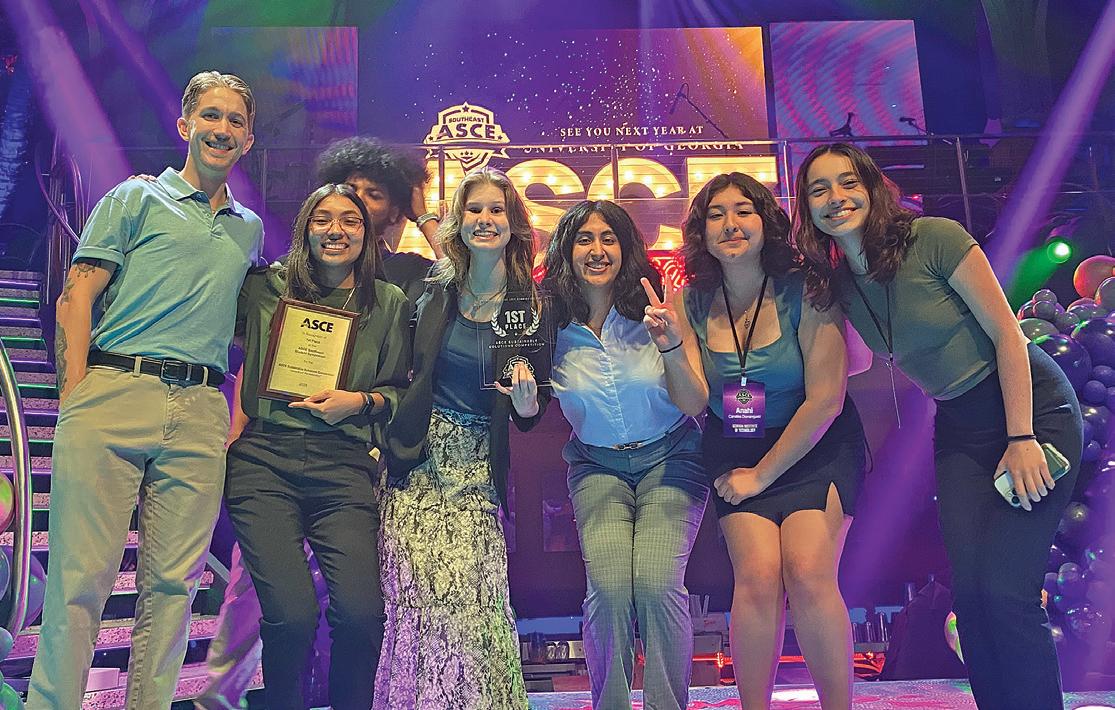
groups had to answer questions about the project, Desai said. During the second part of the competition, each group presented their results as a project proposal.
“Although our team lacked experience with roadway design and construction, we were able to still win first place, which was a great accomplishment,” Desai said.
The GT-ASCE Steel Bridge team finished in second place in two categories and in third place for lightness.
“It was a great bridge, light and strong,” said the team’s advisor, CEE Facilities Manager Andrew Udell. “I am delighted at the chapter’s overall third-place showing.”
See below for the full list of GT-ASCE teams that placed in the top three:
l Sustainable Solutions, led by Mary Helvie.
l Construction Institute, led by Arya Desai.
l Plans Reading, led by Jackie Zong.
l Student Symposium Paper, delivered by Antonia Kopp.

l PCI Prestressed Mini-Beam Competition, led by Ana Contreras.
l Steel Bridge Efficiency, led by Joshua Gargan.
l Steel Bridge Stiffness, led by Joshua Gargan.
l Concrete Canoe - Technical Presentation, led by Daniel Ng.
l Concrete Cornhole, led by Theodore Lemire.
l Steel Bridge Lightness, led by Joshua Gargan. l
The Georgia Tech Steel Bridge team, led by Joshua Gargan, finished in second place in the Efficiency and Stiffness categories. (Photo courtesy GT-ASCE)

By Melissa Fralick
Georgia Tech has won first place at the American Society of Civil Engineers (ASCE) Sustainable Solutions Competition.
This is the second year in a row that the Yellow Jackets have won first place. Georgia Tech bested 17 other teams from around the country in the event, which was part of the ASCE Civil Engineering Student Championships at Brigham Young University June 20-22.
“To say we are elated is an understatement,” said the team’s captain Mary Helvie, a fourth year civil engineering student. “A lot of us (most of all me) felt a lot of pressure from winning the previous year. We had big shoes to fill. We spent countless hours working together on this project and it's something we are extremely proud of.”
The Sustainable Solutions Competition challenges college students to address real-world issues with creative engineering solutions. For the 2024 competition, students were asked to respond to a fictional request for proposals to revitalize and redevelop an abandoned industrial waterfront area in a flood plain.
The area had three parcels the team was charged with designing. Their winning proposal included:
l A stormwater park to minimize flooding and increase water infiltration, inspired by Atlanta’s Rodney Cook Sr. Park and the Georgia Tech EcoCommons.
l A five-story multi-use building with housing units, a grocery store, clinic, gym, bike repair shop, and more.
l An education center, restaurant, and community garden. All of the buildings in this parcel had solar panels and were elevated for flood proofing.
“There was an existing railroad track in one of the parcels that was abandoned and unusable,” Helvie said. “Our team proposed transforming the area into a "rail trail" inspired by Atlanta's rails to trails program. Along this multiuse trail we proposed community markets and a commemorative arch made from the existing railroad tracks.”

Each of the participating schools in the competition were regional winners with impressive projects. Ultimately, Helvie said it was Georgia Tech’s hard work, collaboration, and thoroughness that set them apart.
“We worked together and brainstormed the smallest details leaving no stone unturned,” Helvie said. “We weren't afraid to ask our peers, professors, and industry professionals for guidance when we needed it. Most of all, we each contributed, giving our everything to the project and knew we could rely on our teammates to do the same.”
The team’s faculty advisor, Professor of the Practice Fred Meyer, said the students’ efforts were inspiring.
“I’m so proud of how our students came together to develop such a thoughtful, creative and sustainable design to address the future needs of our society,” Meyer said. l
By Melissa Fralick
W
ith their shared interest in sustainable building practices, civil engineering students Arya Desai and Jackie Zong assembled a new student organization to compete in the U.S. Department of Energy’s annual Solar Decathlon—and won first place in the single-family housing division.
The Solar Decathlon challenges college students from around the world to create innovative, high-performance building designs that address issues related to climate change, affordability, and environmental justice.
Desai, Zong, and other members of their interdisciplinary team traveled to the National Renewable Energy Laboratory in Golden, Colorado, in April to present their concept for an energy-efficient home in Atlanta’s Vine City neighborhood. Out of 10 finalists, the Georgia Tech team was selected as the winner in their division.
“As a majority undergrad team with little experience, to be able to pull off something like that was pretty extraordinary,” said Desai, a third-year civil engineering student and co-founder of the group.
The students aren’t resting on their laurels, however. Following their success at the Solar Decathlon competition, the team is spending the summer working on planning and permitting with the goal of beginning construction on the home at the start of the fall semester.
“Now we have another year to actually finish it out and build the house before we graduate,” Desai said. “It’s going to be extremely difficult but we’re hoping we can pull it off.”
The seeds for Georgia Tech’s Solar Decathlon Team were planted back in 2021. Zong and Desai met in the “Intro to CEE” class during their first year at Tech.
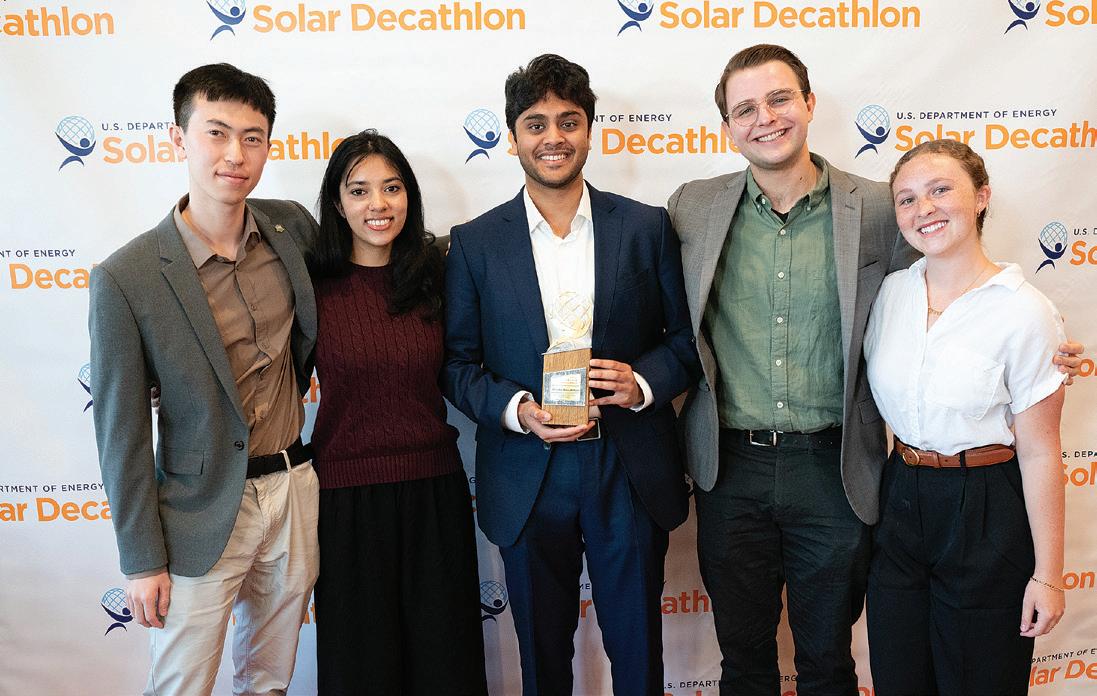

They found they had a lot in common and went on to become active students, both joining Georgia Tech’s chapter of the American Society of Civil Engineers (ASCE).
In the summer of 2023, Zong and Desai were part of a team that won the national Sustainable Solutions Competition at the ASCE Civil Engineering Student Championships.
Following that experience, they decided it was time for a new challenge. “We are both passionate about sustainability in the built environment,” Zong said. “That's why we decided to participate in the [Department of Energy] Solar Decathlon competition.”
That summer, they began making plans to create a Georgia Tech team to compete in the annual event. At the start of the fall semester, they began recruiting and ended up with 15 members from a mix of majors including architecture, civil and environmental engineering, building construction, and business. Zong and Desai rounded out their organization’s leadership team with the addition of Rachel Witherspoon, a master’s student in the School of Architecture.
While teams from Georgia Tech have competed in the Solar Decathlon in the past, they have always been temporary groups connected to a specific course or faculty member.
“The goal of Jackie and I was to make this a student organization,” Desai said. “This isn’t a ‘one and done’ now. It’ll be every single year moving forward and Georgia Tech can become a powerhouse school in this competition.”
Continues on next page

Zong added that they wanted to make this competition accessible to anyone at Georgia Tech.
“We want to start something that’s multidisciplinary and allows students from all majors and years to participate, regardless of experience,” Zong said.
By the end of 2023, the newly minted team’s project was taking shape.
Atlanta ranks fourth in the nation in median energy burden levels and third among lowincome households. The team’s goal was to lower energy costs by developing an affordable, sustainable home that achieves net zero energy consumption while utilizing materials with low carbon footprints.
The team worked with the Westside Future Fund, a local non-profit organization, to secure a lot in the Vine City neighborhood, just a few minutes from Georgia Tech’s campus. They also partnered with Lifecycle Building Center to source reclaimed materials for the project.
In their concept, the team utilized off-the-shelf products to ensure simple maintenance for the homeowner while keeping the system interfaces easy to understand and operate.
Among other strategies, their design includes a oneton air source heat pump to meet the cooling and heating loads and a five-kilowatt solar system to meet the netzero energy goal and reduce the energy burden.
The students traveled to Colorado in April prepared with a 60-page report on their project and delivered a 15-minute presentation in the Solar Decathlon’s final round of competition.
The Georgia Tech team was selected to win first place from 10 teams in the single-family division. That number was whittled down from 26 in the semifinal round, and roughly 40 who submitted an initial project summary.
“It was such an honor for our team to come to first place in the Single-Family Division,” Zong said. “Moreover, Solar Decathlon is the perfect competition that demonstrates how the [Architecture/Engineering/Construction] industry works in the real world. Architects, engineers, and construction professionals have to collaborate with each other to achieve the same goals. The competition prepares students well for the industry after graduation.”
Following their success at the Solar Decathlon, the team is ready to move their plans from design to construction.
This summer, the team is working through the permitting process to build the house on Andrew J Hairston Place in the Vine City neighborhood. Construction costs will be covered by the Westside Future Fund, various grants, and fundraising efforts.
The goal is to complete construction by the spring of 2025 and sell the house to a legacy family from Atlanta’s westside.
“We also want to incorporate workforce training programs, if possible, to help empower local residents and get more people interested in sustainability career pathways,” Zong said.
While construction on the house is underway in the coming academic year, the Solar Decathlon team will begin designing a new project for the 2025 competition, this time in the commercial building category.
With the blessing of the Civil and Environmental Engineering faculty, Desai and Zong plan to incorporate it into their senior capstone design projects.
“We’re going to be balancing that project, with senior capstone, and building the house on top of our coursework,” Desai said. “It’ll be a tough senior year but I’m sure it will be rewarding.” l

Clockwise from top: 1) CEE students, faculty and staff fill the Mason Building plaza to celebrate the 125th anniversary of the School of Civil Engineering; 2) Students in Eric Marks’ Construction Planning and Estimating class take part in a metal stud wall building exercise; 3) Students participate in CEE’s inaugural Lunar New Year celebration; 4) Fred Meyer’s CEE 6523 class on a construction site visit hosted by Brasfield and Gorrie and Uzun + Case; 5) Bill Higginbotham and students on the Sweden Study Abroad program watch a presentation.


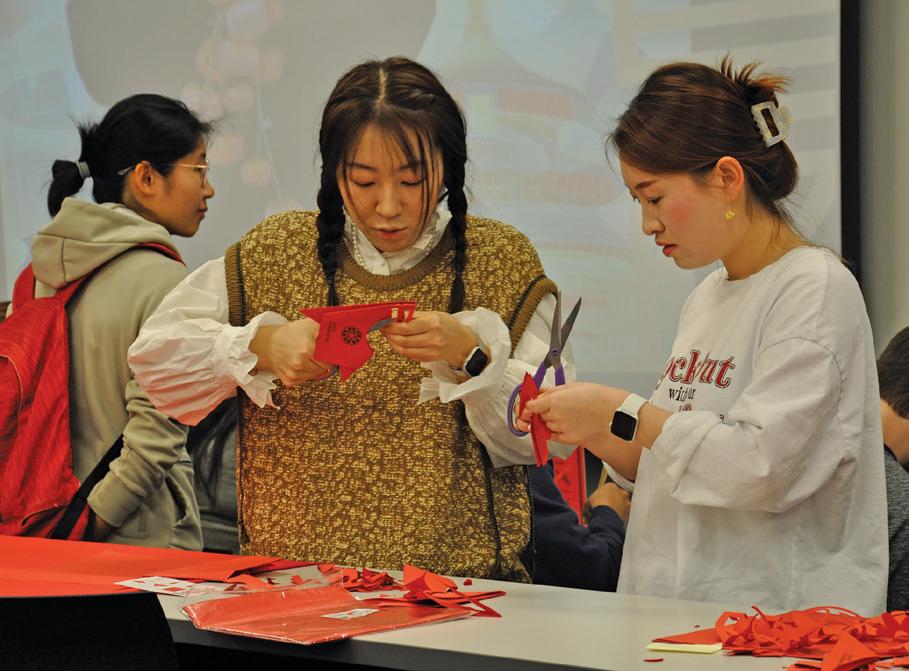






Professor Adjo Amekudzi-Kennedy addresses her CEE Systems class during a presentation.

By Melissa Fralick
Starting this year, all new civil and environmental engineering students will begin their undergraduate journey in an introductory class — creating an immediate connection to their major.
“Exploring CEE” is the first in a series of four classes that will be required courses for all undergrads, representing the School of Civil and Environmental Engineering’s most significant curriculum update in 25 years.
“I am proud of the hard work that our faculty and students have put into piloting the new and modified courses, as well as the thoughtfulness that went into evoking a major curriculum change for our undergraduate degree programs,” said Karen and John Huff School Chair Donald Webster. “The innovation is a clear expression of the strong culture in the School to support our students and deliver cutting-edge educational content and experiences.”
From day one, first-year and transfer students will engage with civil and environmental engineering concepts and begin to build an arsenal of technical and professional skills. Each year, students will take the next in a series of courses that build upon one another. At the end of their journey, students will graduate as holistic engineers with an entrepreneurial mindset prepared for a quickly evolving world.
Continues on next page
“We hope students come in and learn and understand what it's all about to be a civil or environmental engineer and get excited about it,” said Professor Adjo Amekudzi-Kennedy, associate chair for global engineering leadership and entrepreneurship. “They’ll be able to connect with their peers, their instructors, practitioners, and begin to craft their professional identity.”
Behind the scenes, the School’s faculty have been engaged in a multi-pronged effort to modernize the undergraduate curriculum for more than five years.
The centerpiece is a required spine of four courses that will anchor the undergraduate experience. The vertically integrated classes, taken in sequence, focus on interactive problem-based learning around the societal grand challenges that civil and environmental engineers work to decipher, address and solve.

EXPLORING CEE provides first-year and transfer students with a broad overview of civil and environmental engineering topics, and introduces them to real-world engineers
CEE SYSTEMS for second-year students studies the connections among infrastructure systems, sustainability thinking, and community quality of life.
DATA ANALYTICS IN CEE APPLICATIONS is for third-year students to use emerging computational tools to enhance the study of civil and environmental engineering.
CAPSTONE DESIGN is a course for seniors to apply their knowledge to a semester-long design project.
In addition to engineering material, the courses introduce students to skills that will set them apart in their professional lives, such as communication, collaboration, computation, reflection, and entrepreneurship.
The newest course is Data Analytics in CEE Applications, introduced as a pilot course in spring 2023. The class was designed to equip students to apply emerging technologies in machine learning and artificial intelligence in engineering contexts.
“ ”
We are continuously looking at the overall student experience and doing internal and external reflection to see what must evolve and how it must evolve. To me, it’s a culture of adaptation that we must have. It’s a culture shift.
— Professor Adjo Amekudzi-Kennedy
CEE Systems and Capstone Design have long been part of the School’s curriculum but have been revamped with new material and new teaching approaches.
Amekudzi-Kennedy emphasized that the recent changes involve much more than new classes. They’re about changing the way the faculty members engage with students and teach as well as broadening the mindset beyond engineering for a more holistic education.
“We are continuously looking at the overall student experience and doing internal and external reflection to see what must evolve and how it must evolve,” Amekudzi-Kennedy said. “To me, it's a culture of adaptation that we must have. It’s a culture shift.”
Back in 2018, Associate Chair for Undergraduate Programs Kevin Haas analyzed how many students were entering and exiting the School’s programs. What he found was that about half of students who initially declared civil or environmental engineering as their major transferred into a different major, often before they had ever taken a CEE course. Likewise, roughly half of students who ultimately earned a civil or environmental engineering degree originated in a different major before transferring into the School.
CEE leaders concluded that students weren’t learning early enough about exciting aspects of their major. They embarked on the curriculum redesign to help students more strongly identify as a civil or environmental engineer early on, to help foster a sense of belonging, and improve program outcomes.
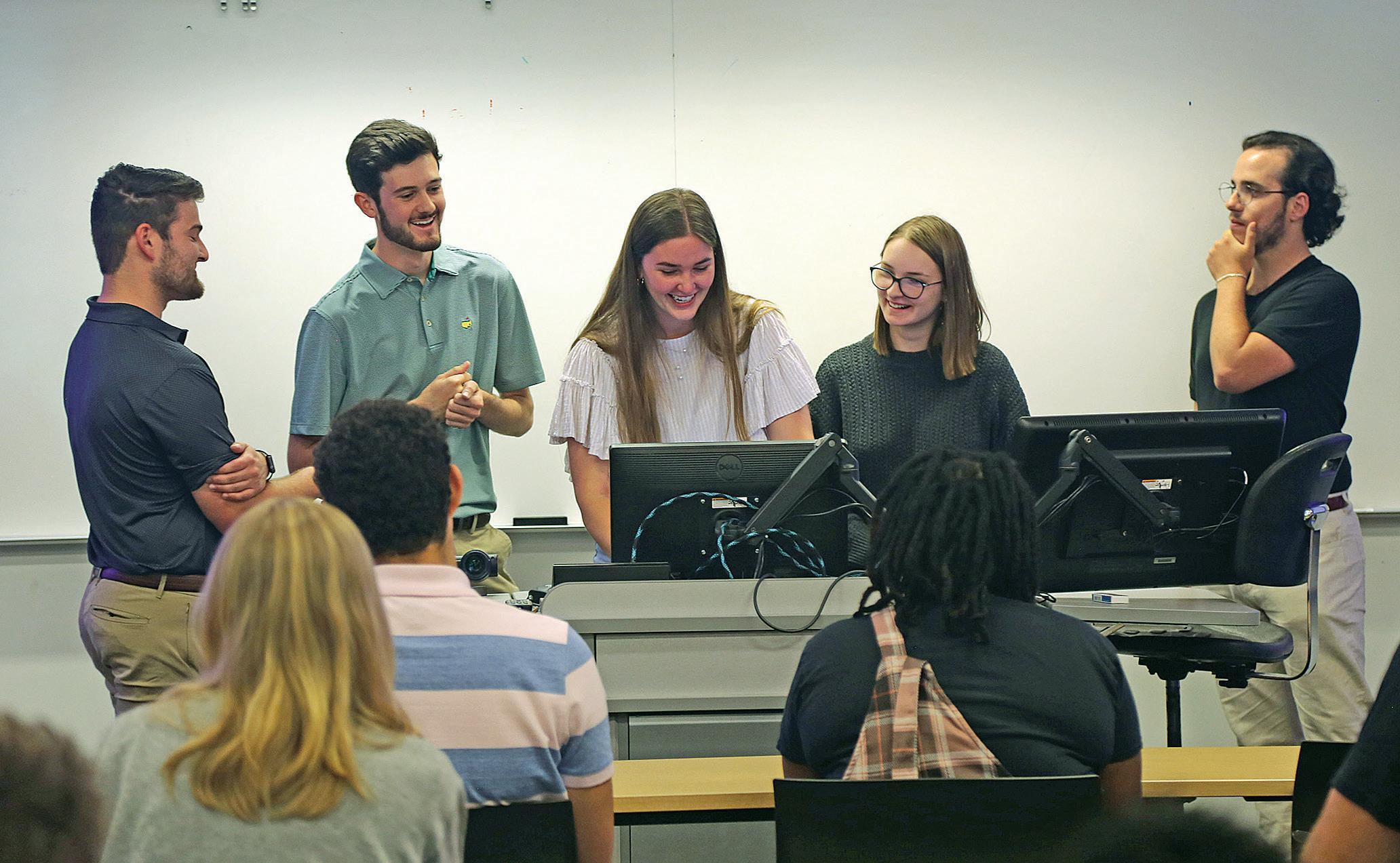
The first step was the 2019 introduction of Exploring CEE as a pilot elective course for new students.
“We're introducing them to topics within civil and environmental engineering right at the beginning and helping them see where they can fit in within the curriculum and within the profession,” Haas said.
Results from the course have been promising. Of those who enrolled in the course as an elective in the fall of 2023, just 15% went on to change their major — significantly lower than the roughly 50% of freshman overall that Haas recorded in 2017.
Former students report benefitting significantly from the class.
Nina Roush started in a different engineering program at Tech before switching her major to civil engineering. She enrolled in Exploring CEE to get a better overview of her new major and applications in the real world.
“The Exploring CEE course was not only helpful for me to learn about CEE, but also to develop professionally and become aware of many of the responsibilities that engineers have in sustaining communities economically, socially, and environmentally,” Roush said. “By the end of the course, I felt like I had a much better grasp on what the major was about and felt like I was in the right major for my career goals and interests.”
Seeing momentum from the Exploring CEE course, faculty leaders wanted to do more.
In 2020, CEE received a $1 million grant from the National Science Foundation’s Revolutionizing Engineering Departments (RED) program.
The funding provided faculty with resources to expand their vision and consider how to engage undergraduate students as they matriculate over the course of four years.
In 2021, the effort was strengthened by a grant from the Kern Family Foundation’s Kern Entrepreneurial Engineering Network (KEEN). CEE was one of four College of Engineering programs selected to help students build an entrepreneurial mindset by infusing story-driven learning and other entrepreneurially-minded learning pedagogies into their curricula.
“Students who have an entrepreneurial mindset are curious, they want to see the big picture, they connect the things they are doing to the broader economy, environment, society and then they know how to create value,” Amekudzi-Kennedy said.

Amekudzi-Kennedy has led the change initiative through the two grant programs over the past few years.
She pointed out that curriculum change can be difficult — particularly when things are going well. In fact, the School received the RED grant the same year that it was named the No. 1 civil engineering program in the nation by U.S. News and World Report
Professor Michael Hunter, Chair of the Undergraduate Curriculum Committee, led an effort to work with small groups of faculty members to get input. The process led to near unanimous support of the initiatives and recognition that the School needed to adapt to a changing world.
Literature on the quickly evolving nature of the practice and education of civil and environmental engineering propelled them forward. Amekudzi-Kennedy said research reported in the Chronicle of Higher Education and other authoritative documents has confirmed that retention is higher and students fare better when they feel a sense of belonging.
Meanwhile, a 2019 American Society of Civil Engineers education summit highlighted the need to elevate professional skills to equal footing with technical skills to keep pace with a changing industry.
Luckily, the School already had a successful model to integrate those professional skills, thanks to Principal Academic Professional Lisa Rosenstein and her embedded Engineering Communications Program.
The communications program integrates written, oral, and visual communication skills within relevant and discipline-specific problems, where students learn not only skills, but also the philosophy that underpins effective communication.
As part of the professional formation component of the recent curriculum revamp, CEE followed a similar model to embed teaming skills development into all four spine courses, at increasing levels of maturity. Exercises in those classes teach students strategies for working effectively on teams, small group activities allow students to take varying roles on a team, and students learn strategies for conflict resolution and team leadership.
“With these curriculum changes emphasizing belonging and professional skills, we are building on our legacy as a forwardthinking civil and environmental engineering program,” Webster said. “I am confident that our students will graduate ready to succeed as civil and environmental engineers today and push the boundaries of the discipline into the future.” l
By W. Blair Meeks
The Chattahoochee River cuts a rollicking, boisterous path alongside the downtown area of Columbus, Georgia. With its long, constructed section of rapids, the area of the river through Columbus is well-known in kayaking circles as some of the best whitewater in the state, and its picturesque twists and turns draw visitors to walk its banks and invite them to rock-hop along tiny stone islands that are exposed when water levels are low.
But this whitewater also presents a lifethreatening problem.
A dam upstream can increase water levels within minutes, and those who aren’t familiar with the area can be surprised and swept away by rushing water. Civic leaders have put up warning signs, and sirens blare when water levels are rising, but despite the many warnings, there are water rescues and even drownings at this area of the river every year.
“Growing up around here, you’re always told, ‘Don’t get in that river. That river will suck you under. You don’t get in there,’” says Jeremy Miles, assistant IT director for the city of Columbus. “But now on a pretty day, you’ll see a lot of people in the river and beside the river. It’s a new fad. And we also have this great whitewater course, so it’s an attraction that brings people from all over.”
For emergency responders, getting a precise location when someone is in danger is critical to favorable outcomes, and those in Columbus emergency circles say that is difficult on the river.
“We will have an emergency on the river, and we’ll have the wrong location given to us, and what happens is we’ll bring the wrong piece of equipment or find out it’s in another part of the river,” says Deputy Chief Daniel Macon of Columbus Fire & EMS.
This can waste precious seconds during an emergency, which is why Georgia Tech researchers wanted to find a solution.
“After a year and a half of effort,” said John Taylor, Frederick Law Olmsted Professor in Georgia Tech’s School of Civil and Environmental Engineering, “we’ve created a system that can identify people who might be in trouble on the river and give rescue workers precise

information that will allow them to get people out of harm’s way or get them out of the water if they’ve fallen in.”
Cameras mounted on a bridge over the river send a constant signal of activity below. A computer algorithm that’s part of the smart river safety digital twin scans the images, identifying people and placement.
Using data from other monitoring devices, the system will predict when rising water will put people in danger. The system sends alerts with precise information on location, and emergency responders immediately know what to do and, more importantly, where they need to do it.
A yellow alert lets responders know someone is in a danger zone. An orange alert means someone is in a danger zone, and water levels are rising quickly. A red alert tells crews that someone is in the water with no boat or kayak nearby and is at risk of drowning.
During a test with Swiftwater/Flood Search and Rescue Team members in October, researchers and city leaders were able to see the system in action.
Neda Mohammadi, another Georgia Tech researcher and project lead from the School of Civil and Environmental Engineering says, “We’ve been testing the system live and in real time, and it’s really rewarding to see that it’s working and that what we’ve anticipated really took place.”
The work is part of Partnership for Inclusive Innovation, a public-private initiative based out of Georgia Tech that catalyzes innovation for shared economic prosperity. It invests in projects that join researchers with communities to provide advanced technologies to build local capacity and improve the human condition.
Columbus firefighter Captain Stephen Funk says, “It means time. It means a matter of life and death. And it means having the right people in the right place.” l
— Professor John Taylor “ ”
After a year and a half of effort, we’ve created a system that can identify people who might be in trouble on the river and give rescue workers precise information that will allow them to get people out of harm’s way or get them out of the water if they’ve fallen in.

By W. Blair Meeks
Areas of a middle Georgia city have experienced a 20% reduction in crime after deploying a system of mobile cameras guided by an algorithm developed by Georgia Tech researchers.
The system is being piloted in Warner Robins, Georgia. It uses artificial intelligence to sift through years of historical crime data to predict where future crimes are likely to happen, and by placing cameras that can read license plates in those areas, a three-month test period shows the community has been able to prevent some of those crimes.
“The fact that we have our cameras in different areas in our city, that smart technology expands the footprint of our police department which helps us solve crime and also helps deter crime, which is even more beneficial,” said Warner Robins Mayor LaRhonda Patrick.
For cities and counties with limited resources, it’s a tool that could bring more impact with the money and equipment that is already being used to reduce crime.
Georgia Tech’s John Taylor, a professor in the School of Civil and Environmental Engineering, says, “When we were brought in, there was a general belief that crimes were really occurring in certain parts of the city, but as we looked at the crimes from week to week, we saw that they're actually moving around the city.”
The work is part of Georgia Tech’s Partnership for Inclusive Innovation, a public-private initiative that catalyzes innovation for shared economic prosperity. It invests in projects that join researchers with communities to bring advanced technologies to build local capacity and improve the human condition.
Over the three months, researchers saw a reduction in crimes such as assault and burglary. Georgia Tech is helping the city deploy a more equitable solution in using cameras to fight crime and helping extend the city’s budget and its police officers’ work to make their community safer. l
By Catherine Barzler
Gigatons of greenhouse gas are trapped under the seafloor, and that’s a good thing. Around the coasts of the continents, where slopes sink down into the sea, tiny cages of ice trap methane gas, preventing it from escaping and bubbling up into the atmosphere.
While rarely in the news, these ice cage formations, known as methane clathrates, have garnered attention because of their potential to affect climate change. During offshore drilling, methane ice can get stuck in pipes, causing them to freeze and burst. The 2010 Deepwater Horizon oil spill is thought to have been caused by a buildup of methane clathrates.
But until now, the biological process behind how methane gas remains stable under the sea has been almost completely unknown. In a breakthrough study, a cross-disciplinary team of Georgia Tech researchers discovered a previously unknown class of bacterial proteins that play a crucial role in the formation and stability of methane clathrates.
A team led by Jennifer Glass, associate professor in the School of Earth and Atmospheric Sciences, and Raquel Lieberman, professor and Sepcic-Pfeil Chair in the School of Chemistry and Biochemistry, showed that these novel bacterial proteins suppress the growth of methane clathrates as effectively as commercial chemicals currently used in drilling, but are non-toxic, eco-friendly, and scalable. Their study, funded by NASA, informs the search for life in the solar system, and could also increase the safety of transporting natural gas.
The research, published in the journal PNAS Nexus, underscores the importance of fundamental science in studying Earth’s natural biological systems and highlights the benefits of collaboration across disciplines.
“We wanted to understand how these formations were staying stable under the seafloor, and precisely what mechanisms were contributing to their stability,” Glass said. “This is something no one has done before.”
The effort started with the team examining a sample of clay-like sediment that Glass acquired from the seafloor off the coast of Oregon.
Glass hypothesized that the sediment would contain proteins that influence the growth of methane clathrate, and that those proteins would resemble well-known antifreeze proteins in fish, which help them survive in cold environments.
But to confirm her hypothesis, Glass and her research team would first have to identify protein candidates out of millions of potential targets contained in the sediment. They would then need to make the proteins in the lab, though there was no understanding of how these proteins might behave. Also, no one had worked with these proteins before.
Glass approached Lieberman, whose lab studies the structure of proteins. The first step was to use DNA sequencing paired with bioinformatics to identify the genes of the proteins contained in the sediment. Dustin Huard, a researcher in Lieberman’s lab and first author of the paper, then prepared candidate proteins that could Continues on next page

Methane clathrate (white, ice-like material) under a rock from the seafloor of the northern Gulf of Mexico. Deposits such as these demonstrate that methane and other gases cross the seafloor and enter the ocean. Photo credit: NOAA
potentially bind to the methane clathrates. Huard used X-ray crystallography to determine the structure of the proteins.
Creating Seafloor Conditions in the Lab
Huard passed off the protein candidates to Abigail Johnson, a former Ph.D. student in Glass’ lab and co-first author on the paper, who is now a postdoctoral researcher at the University of Georgia. To test the proteins, Johnson formed methane clathrates herself by recreating the high pressure and low temperature of the seafloor in the lab. Johnson worked with Sheng Dai, an associate professor in the School of Civil and Environmental Engineering, to build a unique pressure chamber from scratch.
Johnson placed the proteins in the pressure vessel and adjusted the system to mimic the pressure and temperature conditions required for clathrate formation. By pressurizing the vessel with methane, Johnson forced methane into the droplet, which caused a methane clathrate structure to form.
the protein did not play a role, and a wholly different mechanism directed the interactions.
They found that the proteins do not bind to ice, but rather interact with the clathrate structure itself, directing its growth. Specifically, the part of the protein that had similar characteristics to antifreeze proteins was buried in the protein structure, and instead played a role in stabilizing the protein.

The researchers found that the proteins performed better at modifying methane clathrate than any of the antifreeze proteins that had been tested in the past. They also performed just as well as, if not better than, the toxic commercial clathrate inhibitors currently used in drilling that pose serious environmental threats.
Preventing clathrate formation in natural gas pipelines is a billion-dollar industry. If these biodegradable proteins could be used to prevent disastrous natural gas leaks, it would greatly reduce the risk of environmental damage.
She then measured the amount of gas that was consumed by the clathrate — an indicator of how quickly and how much clathrate formed — and did so in the presence of the proteins versus no proteins. Johnson found that with the clathratebinding proteins, less gas was consumed, and the clathrates melted at higher temperatures.
Once the team validated that the proteins affect the formation and stability of methane clathrates, they used Huard's protein crystal structure to carry out molecular dynamics simulations with the help of James (JC) Gumbart, professor in the School of Physics. The simulations allowed the team to identify the specific site where the protein binds to the methane clathrate.
The study unveiled unexpected insights into the structure and function of the proteins. The researchers initially thought the part of the protein that was similar to fish antifreeze proteins would play a role in clathrate binding. Surprisingly, that part of
“We were so lucky that this actually worked, because even though we chose these proteins based on their similarity to antifreeze proteins, they are completely different,” Johnson said. “They have a similar function in nature, but do so through a completely different biological system, and I think that really excites people.”
Methane clathrates likely exist throughout the solar system — on the subsurface of Mars, for example, and on icy moons in the outer solar system, such as Europa. The team’s findings indicate that if microbes exist on other planetary bodies, they might produce similar biomolecules to retain liquid water in channels in the clathrate that could sustain life.
“We’re still learning so much about the basic systems on our planet,” Huard said. “That’s one of the great things about Georgia Tech — different communities can come together to do really cool, unexpected science. I never thought I would be working on an astrobiology project, but here we are, and we’ve been very successful.” l
By Catherine Barzler
What’s in a name? A lot, actually.
For the scientific community, names and labels help organize the world’s organisms so they can be identified, studied, and regulated. But for bacteria, there has never been a reliable method to cohesively organize them into species and strains. It’s a problem, because bacteria are one of the most prevalent life forms, making up roughly 75% of all living species on Earth.
An international research team sought to overcome this challenge, which has long plagued scientists who study bacteria. Kostas Konstantinidis, Richard C. Tucker Professor in the School of Civil and Environmental Engineering at the Georgia Institute of Technology, co-led a study to investigate natural divisions in bacteria with a goal of determining a scientifically viable method for organizing them into species and strains. To do this, the researchers let the data show them the way.
Their research was published in the journal Nature Communications
“While there is a working definition for species and strains, this is far from widely accepted in the scientific community,” Konstantinidis said. “This is because those classifications are based on humans’ standards that do not necessarily translate well to the patterns we see in the natural environment.”
For instance, he said, “If we were to classify primates using the same standards that are used to classify E. coli, then all primates — from lemurs to humans to chimpanzees — would belong to a single species.”
There are many reasons why a comprehensive organizing system has been hard to devise, but it often comes down to who gets the most attention and why. More scientific attention generally leads to those bacteria becoming more narrowly defined. For example, bacteria species that contain toxic strains have been extensively studied because of their associations with disease and health. This has been out of the necessity to differentiate harmful strains from harmless ones. Recent discoveries have shown, however, that even defining types of bacteria by their toxicity is unreliable.


developed early in his career. ANI is a robust measure of relatedness between any two genomes and is used to study relatedness among microorganisms and viruses, as well as animals. For instance, the ANI between humans and chimpanzees is about 98.7%.
The analysis confirmed the team’s previous observations that microbial species do exist and could be reliably described using ANI. They found that members of the same species of bacteria showed genetic relatedness typically ranging from 96 to 100% on the ANI scale, and generally less than 85% relatedness with members of other species.
The data revealed a natural gap in ANI values around 99.5% ANI within the Salinibacter ruber species that could be used to differentiate the species into its various strains. In a companion paper published in mBio, the flagship journal of the American Society for Microbiology, the team examined about 300 additional bacterial species based on 18,000 genomes that had been recently sequenced and become available in public databases. They observed similar diversity patterns in more than 95% of the species.
“Despite the obvious, cornerstone importance of the concepts of species and strains for microbiology, these remain, nonetheless, ill-defined and confusing,” Konstantinidis said.
The research team collected bacteria from two salterns in Spain. Salterns are built structures in which seawater evaporates to form salt for consumption. They harbor diverse communities of microorganisms and are ideal locations to study bacteria in their natural environment. This is important for understanding diversity in populations because bacteria often undergo genetic changes when exposed in lab environments.
The team recovered and sequenced 138 random isolates of Salinibacter ruber bacteria from these salterns. To identify natural gaps in genetic diversity, the researchers then compared the isolates against themselves using a measurement known as average nucleotide identity (ANI) — a concept Konstantinidis
“We think this work expands the molecular toolbox for accurately describing important units of diversity at the species level and within species, and we believe it will benefit future microdiversity studies across clinical and environmental settings,” Konstantinidis said.
The team expects their research will be of interest to any professional working with bacteria, including evolutionary biologists, taxonomists, ecologists, environmental engineers, clinicians, bioinformaticians, regulatory agencies, and others. It is available online through Konstantinidis’ website and GitHub to facilitate access and use by scientific and regulatory communities.
“We hope that these communities will embrace the new results and methodologies for the more robust and reliable identification of species and strains they offer, compared to the current practice,” Konstantinidis said. l
By Jerry Grillo
T
wenty years ago, when strangers would ask Hermann Fritz about his job and he told them he was a tsunami expert, he got plenty of quizzical looks in response.
“The 2004 Indian Ocean earthquake changed everything,” said Fritz, a young researcher whose Ph.D. was barely two years old at the time, recalling the powerful undersea megathrust off the Indonesian coast that caused the ocean floor to rise on Boxing Day. It triggered a massive, deadly tsunami with 100-foot waves that killed nearly 230,000 people in 14 countries, the last of them 5,000 miles from the earthquake epicenter.
“Overnight, everyone in the world knew about tsunamis,” said Fritz, now a professor in the School of Civil and Environmental Engineering at Georgia Tech. He worked post-disaster reconnaissance operations in countries devastated by that 2004 tsunami.
In the years since, he has led or participated in at least a dozen other such scientific missions, in the wake of tsunamis, hurricanes, landslides, and earthquakes. His wide-ranging research centers on fluid dynamics in these natural (and human-made) disasters, but also on their mitigation and coastal protection. That’s where his latest research, published in the journal Physics of Fluids, is aimed.
Fritz and his former graduate student, Yibin Liu, are interested in a specific kind of tsunami, those caused by underwater volcanic eruptions and landslides. So, they built a volcanic tsunami generator in a wave basin — essentially, a large lab-in-a-tank for studying wave behavior, the O.H. Hinsdale Wave Research Laboratory, a National Science Foundation-supported Natural Hazards Engineering Research Infrastructure facility at Oregon State University.
“The recent underwater volcanic eruptions of 2018 at Anak Krakatau and the 2022 Tonga event caused tsunami hazards with extensive casualties and economic impacts,” Liu said. “That’s what motivated this project — the limited scientific understanding and field data of tsunami generation mechanisms.”
The tsunami generation process is the transfer of mechanical and thermal energy from volcanic activities into the surrounding body of water. To mimic this behavior for their observation, the researchers built a pneumatic volcanic tsunami generator (VTG). Tsunami waves are generated by sending a vertical column of water up through the water surface. Then the water surface deformation was measured with cameras and wave gauges.
“This design, with multiple pneumatic cylinders, can reach a wide spectrum of motion patterns to simulate various types of underwater volcanic eruptions,” said Liu. These cylinders use compressed gas to produce the necessary force that ultimately leads to a simulated tsunami. The VTG, which they

“Ultimately it came down to developing a volcanic tsunami generator that would allow for safe, controlled, and reproducible experiments of an isolated volcanic tsunami generation mechanism.”
— Hermann Fritz
installed on the basin floor at Oregon State, is essentially the next generation of technology they’d used in previous studies.
“We had studied tsunamis from non-tectonic sources, such as submarine landslides, for decades, and we had previously used pneumatics to drive gravel landslides and were familiar with the pneumatic controls and rapid accelerations,” Fritz said. “Ultimately it came down to developing a volcanic tsunami generator that would allow for safe, controlled, and reproducible experiments of an isolated volcanic tsunami generation mechanism.”
They conducted more than 300 experiments on the simulator, recreating different volcanic conditions. The 3D data they gathered will ideally lead to better tsunami models for future events, which can be very unpredictable. The Anak Krakatau event in 2018 is a great example.
“It had basically been announcing a potential tsunami hazard by erupting for six months before collapsing and triggering a tsunami that still took more than 400 lives,” Fritz said.
He added, “The beauty of physical modeling is that it allows us to safely study details of volcanic tsunami generation at reduced scale and fill gaps in rare, real-world observations of volcanic tsunamis. Ultimately, the broader impacts of this research are to raise tsunami awareness, educate, and contribute to saving lives.” l
By Tess Malone
The water coming out of your faucet is safe to drink, but that doesn’t mean it’s completely clean. Chlorine has long been the standard for water treatment, but it often contains trace levels of disinfection byproducts and unknown contaminants. Georgia Institute of Technology researchers developed the minus approach to handle these harmful byproducts.
Instead of relying on traditional chemical addition (known as the plus approach), the minus approach avoids disinfectants, chemical coagulants, and advanced oxidation processes typical to water treatment processes. It uses a unique mix of filtration methods to remove byproducts and pathogens, enabling water treatment centers to use ultraviolet light and much smaller doses of chemical disinfectants to minimize future bacterial growth down the distribution system.
“The minus approach is a groundbreaking philosophical concept in water treatment,” said Yongsheng Chen, the Bonnie W. and Charles W. Moorman IV Professor in the School of Civil and Environmental Engineering. “Its primary objective is to achieve these outcomes while minimizing the reliance on chemical treatments, which can give rise to various issues in the main water treatment stream.”
Chen and his student Elliot Reid, the primary author, presented the minus approach in the paper, “The Minus Approach Can Redefine the Standard of Practice of Drinking Water Treatment,” in The American Chemical Society
The minus approach physically separates emerging contaminants and disinfection byproducts from the main water treatment process using these already proven processes:
l Bank filtration withdraws water from naturally occurring or constructed banks like rivers or lakes. As the water travels through the layers of soil and gravel, it naturally filters out impurities, suspended particles, and certain microorganisms.
l Biofiltration uses biological processes to treat water by passing it through filter beds made of sand, gravel, or activated carbon that can support the growth of beneficial microorganisms, which in turn can remove contaminants.
l Adsorption occurs when an adsorbent material like activated carbon is used to trap contaminants.
l Membrane filtration uses a semipermeable membrane to separate particles and impurities from the main treatment process.
R
esearchers from Georgia Tech's School of Civil and Environmental Engineering received a $2.1 million grant from the U.S. Environmental Protection Agency (EPA) to investigate contaminants in drinking water.
The EPA is funding the research on the occurrence and concentration of pathogens and disinfection by-products and the environmental conditions favorable to their growth in drinking water distribution systems.
Carlton S. Wilder Associate Professor Ameet Pinto, the project's principal investigator, said disinfection is used to kill microorganisms to make drinking water safe for consumption. Yet, disinfecting to kill microorganisms can also result in formation of harmful disinfection by-products.
“Our key project goal is to shine a light on when, where, and why pathogens and disinfection by-products occur and co-occur in drinking water systems across the country,” Pinto said. “This will help water utilities better navigate the tradeoff of managing microbiological and chemical risks in drinking water and thus enhance the reliability of safe drinking water supply to their consumers.”

The minus approach is intended to engage the water community in designing safer, more sustainable, and more intelligent systems. Because its technologies are already available and proven, the minus approach can be implemented immediately.
It can also integrate with artificial intelligence (AI) to improve filtration’s effectiveness. AI can aid process optimization, predictive maintenance, faulty detection and diagnosis, energy optimization, and decision-support systems. AI models have also been able to reliably predict the origin of different types of pollution in source water, and models have also successfully detected pipeline damage and microbial contamination, allowing for quick and efficient maintenance.
“This innovative philosophy seeks to revolutionize traditional water treatment practices by providing a more sustainable and environmentally friendly solution,” Chen said. “By reducing the reliance on chemical treatments, the minus approach mitigates the potential risks associated with the use of such chemicals, promoting a safer water supply for both human consumption and environmental protection.” l
According to the EPA, opportunistic pathogens such as Legionella pneumophila, nontuberculous mycobacteria, and Pseudomonas aeruginosa can grow in drinking water systems and pose potential risks to public health. The occurrence of these and other microbial pathogens is also associated with contaminated storage facilities and other problems in water distribution systems such as backflow and low-pressure incidents.
If left untreated, these contamination events can lead to outbreaks of gastrointestinal, respiratory, and other waterborne illnesses. The disinfectants used to control these pathogens can cause additional problems by reacting with natural organic matter, bromide, and other contaminants to form disinfectant by-products, which also have the potential to be harmful to human health.
Georgia Tech is one of four institutions selected by the EPA to receive nearly $8.5 million in grant funding, along with the University of Minnesota, Michigan State University, and the University of Texas. The Georgia Tech team includes Turnipseed Family Chair & Professor Ching-Hua Huang and Assistant Professor Katy Graham. l
Patricia Mokhtarian is part of a 2024 class that includes 114 new members and 21 international members. Election to the National Academy of Engineering (NAE) is among the highest professional recognitions for engineers and an honor bestowed on just 2,600 professionals worldwide.
Mokhtarian is the inaugural Clifford and William Greene, Jr. Professor in the School of Civil and Environmental Engineering, where she studies travel behavior, including the travel-related impacts of information and communication technology and other topics. The NAE cited Mokhtarian’s work that “improved transportation systems planning and practice through quantifying human behavior” in electing her to the Academy.
Mokhtarian’s research put her in prime position as the Covid-19 pandemic upended
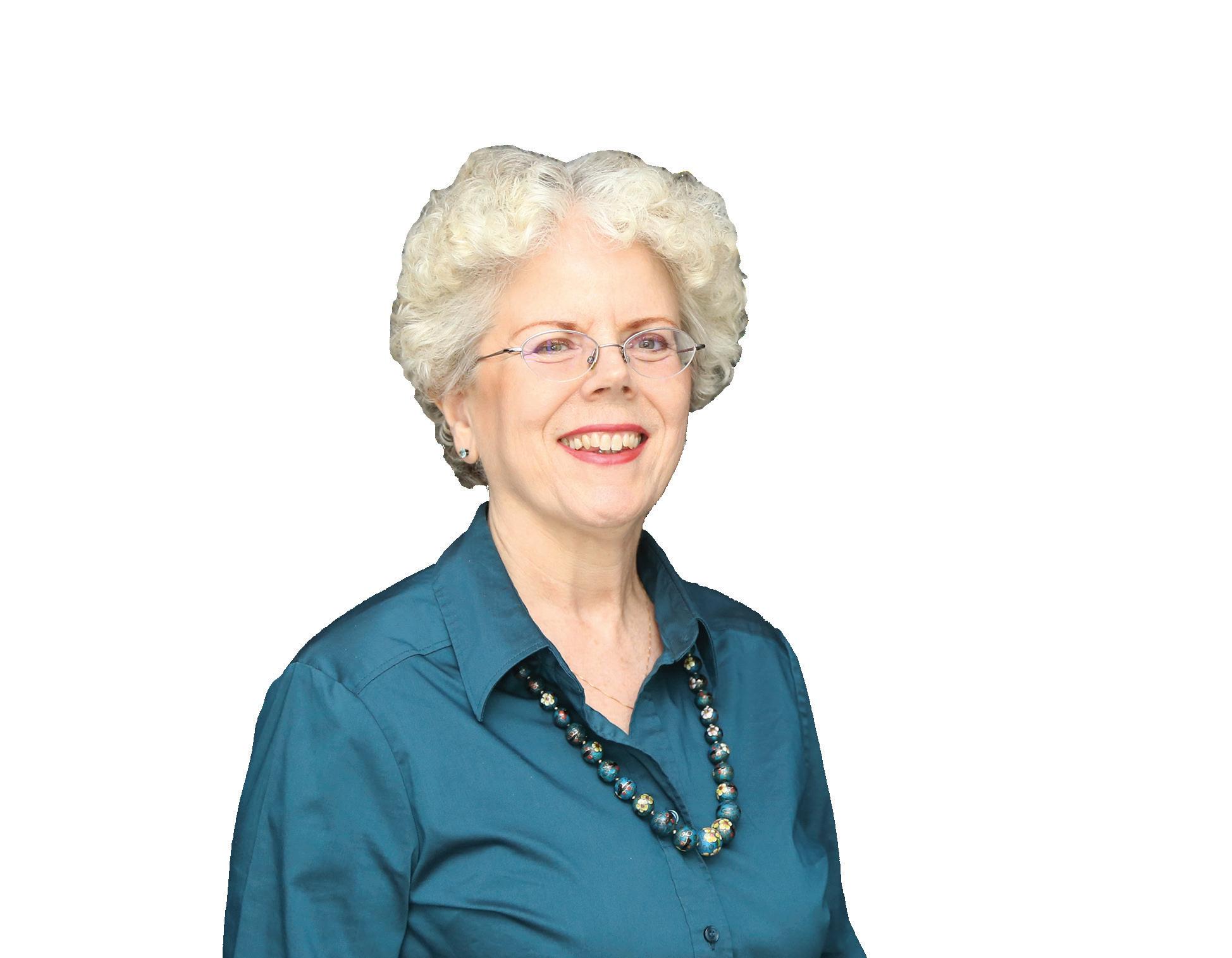
working life for many office-based professionals and gave remote work a seismic boost. She has become a go-to expert for national news organizations as the fallout of those changes continues to reverberate and teleworking has become a regular part of many employees’ lives.
Most recently, Mokhtarian helped launch the federally funded Center for Understanding Future Travel Behavior and Demand in 2023. She serves as associate director of the University Transportation Center, which is focused on creating new models and tools to help planners understand rapidly emerging technology, changing economics, and new societal values that are shaping the modern transportation environment.
Mokhtarian is among the most frequently cited scholars in transportation research. In 2021, she received the Lifetime Achievement Award from the International Association for Travel Behaviour Research for her contributions to the field. l
Karen and John Huff School Chair and Professor Don Webster has joined the top civil engineers in the country as a fellow of the American Society of Civil Engineers (ASCE).
Accounting for just 3 percent of members, fellows “have made celebrated contributions and developed creative solutions that change lives around the world,” according to ASCE.
Webster was selected as a fellow for his contributions as a researcher, educator, and administrator.
As a teacher, Webster has been recognized for his use of the “flipped classroom.” In this teaching model, students watch a recorded lecture before class and use classroom time for hands-
on learning and interaction with their instructor.
Among the teaching honors he’s received are the Felton Jenkins, Jr. Hall of Fame Faculty Award from the University System of Georgia, and Georgia Tech’s Class of 1934 Outstanding Innovative Use of Education Technology Award. Webster was named chair of the School of Civil and Environmental Engineering in 2018, and was reappointed for a second five-year term in 2023.

Webster’s research expertise lies in environmental fluid mechanics focused on the influence of fluid motion and turbulence on biological systems. His contributions have been in three arenas: Illuminating the fluid mechanics processes related to sensory biology and biomechanics, developing advanced experimental techniques and facilities, and translating research results into bio-inspired design. l
The positions are the University System of Georgia’s highest recognition for academic, research, and innovation excellence.



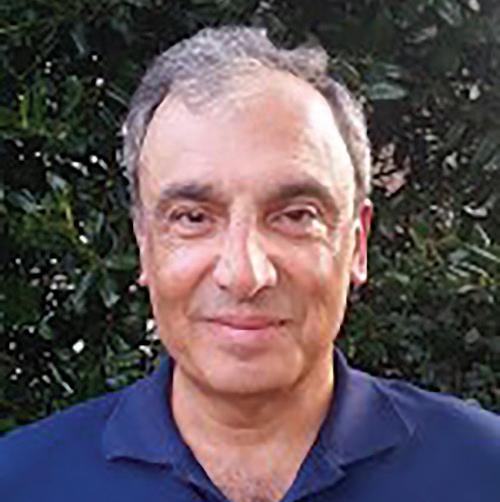
Rafael Bras
Regents’ Professor
K. Harrison Brown Family Chair and Professor
Bras is a renowned scholar of Earth’s water cycle. He helped create the field of hydrologic science by reshaping thinking about water in the environment early in his career. Bras has helped lead significant projects around the world, including efforts to protect Venice, Italy, from flooding. Most recently, he has been engaged in understanding the occurrence of landslides and related geohazards triggered by heavy rainfalls, including hurricanes, in his native Puerto Rico. Bras also served for 10 years as Georgia Tech’s provost and executive vice president for academic affairs.
J. David Frost
Regents’ Entrepreneur
Elizabeth and Bill Higginbotham Professor
Frost is a leader in the study and analysis of natural and man-made disasters. His research centers on the development and implementation of digital data collection systems for studying subsurface problems related to earthquakes and other disasters. For more than 20 years, he has served on or led NSF-supported post-disaster study teams following earthquakes around the world as well as at the World Trade Center complex following the Sept. 11 attacks. Frost has founded two software companies involving intellectual property developed at Georgia Tech. The software currently is used in both infrastructure construction and post‐disaster reconnaissance.
Patricia Mokhtarian
Regents’ Professor
Clifford and William Greene, Jr. Professor
Mokhtarian studies travel behavior, including the travel-related impacts of information and communication technology and other topics. She has become a go-to resource for journalists as the ripple effects of the Covid-19 pandemic continue to radiate through the nation’s workplaces. In 2023, Mokhtarian helped launch the federally funded Center for Understanding Future Travel Behavior and Demand. She serves as associate director of the University Transportation Center, which is focused on creating new models and tools to help planners understand rapidly emerging technology, changing economics, and new societal values that are shaping the modern transportation environment.
M. Talat Odman
Regents’ Researcher
Regent’s Researcher
Odman has decades of research expertise in atmospheric chemistry, air pollution meteorology, and air quality modeling. Since 2007, his research has focused on wildland fires and their impacts on air quality. Insights from his work have led to the development of simulation and decision-support models that are widely used in the field of air pollution management. Odman has led modeling efforts for the state of Georgia’s air quality forecasting for 15 years. He works with the Georgia Department of Natural Resources on its applied air quality research, focusing on a joint air quality and prescribed fire management initiative with the Georgia Forestry Commission.

Assistant Professor Ryan Sherman has been awarded the American Institute of Steel Construction’s (AISC) 2023 Milek Fellowship in recognition of his innovative research on metallic additive manufacturing. Since 2004, AISC has given a promising non-tenured university faculty member the four-year, $200,000 award. Specifically, Sherman will look into material factors, mechanical and small-scale component testing of various connection types, and computational analyses and large-scale testing to demonstrate structural steel applications.

Greene Early Career Professor Jennifer Kaiser and Professor Jian Luo have been selected as faculty fellows for the Brook Byers Institute for Sustainable Systems. They are among 11 faculty from across Georgia Tech selected for the honor this year. Among other things, they will serve in an advisory capacity for the center and foster the culture and community of sustainability researchers, educators, and students at Georgia Tech. Kaiser’s research examines the formation of air pollutants, with a focus on the emissions and chemistry of volatile organic compounds. Luo’s research involves field, theoretical, and computational investigations of flow and reactive transport in subsurface water.



Professor Yong Kwon Cho has been named the recipient of the 2024 Computing in Civil Engineering Award by the Computing Division of the American Society of Civil Engineers (ASCE). The award recognizes Cho's leadership in advancing construction automation and robotics, specifically focusing on enhancing productivity, safety, and intelligence on construction sites. Cho's work encompasses a wide array of technologies, including 3D point cloud processing, Scan-to-BIM (Building Information Modeling), SLAM (Simultaneous Localization and Mapping), IoTbased worker's motion and location, and equipment proximity tracking.
John Koon was honored as the Georgia Society of Professional Engineers’ 2024 Engineer of the Year. Koon is a recently retired professor of the practice in the School of Civil and Environmental Engineering. His career spans over 40 years, with significant contributions to wastewater treatment and environmental engineering. A significant amount of his experience has involved solving environmental problems in chemically complex systems. He has been a key contributor to significant advances in the technologies used worldwide in the treatment of industrial wastewaters.


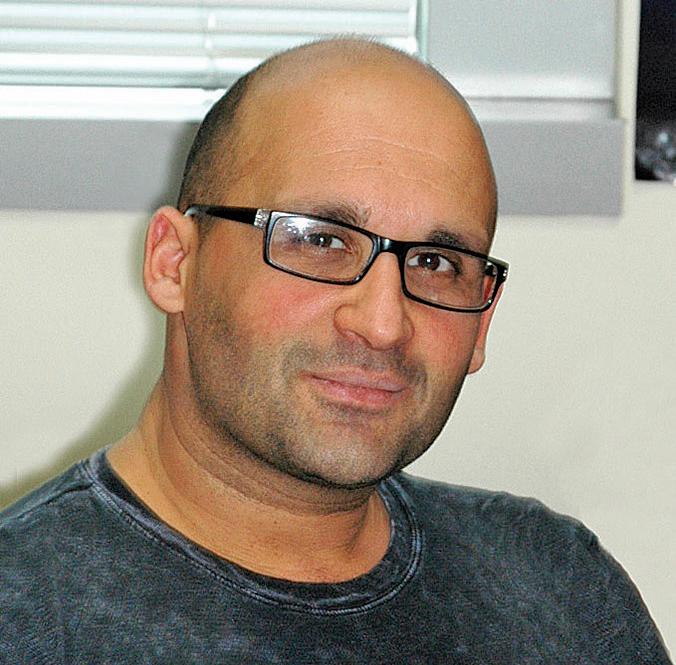
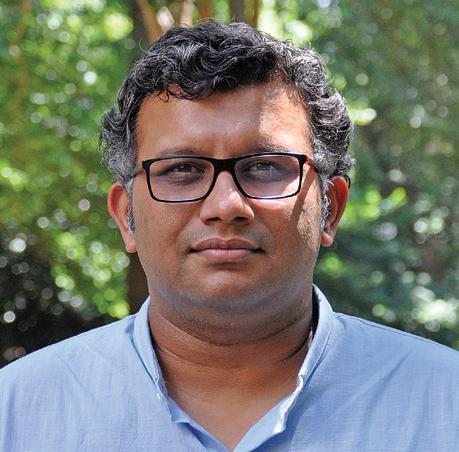
Associate Professor Xing Xie was selected to receive a prestigious research award from the American Society of Civil Engineers. Recipients of the Walter L. Huber Award are selected based on the impact of their research, both on their chosen subdisciplines, as well as on the field of civil engineering more broadly. Xie’s research includes the areas of environmental nanotechnology, water and wastewater treatment, energy and resources recovery and energy conversion and storage.
Frederick Law Olmsted Professor John E. Taylor was awarded the 2023 Pathfinder Award from the Engineering Project Organization Society (EPOS). The Pathfinder Award is the highest award given by EPOS. Taylor, who also serves as the Associate Chair for Faculty Development and Research Innovation, was recognized for his “research and boundary-spanning abilities and continued dedication, leadership, and inspiration to the next generation of boundary-spanning and pathfinding researchers.”
This award recognizes faculty who are improving the quality of education at Georgia Tech through pedagogical and curricular innovation. Fedele created the course Arts and Geometry in 2018, which engages students in learning how fundamental concepts in geometry have infused the work of influential scientists and artists who have advanced important innovations in their fields. Each semester, he has collaborated with local artists to expose students to artists, artists’ work, and artistic methods.
Carlton S. Wilder Early Career Professor Ameet Pinto has been selected as a Fellow of the International Water Association (IWA). Pinto was chosen for the honor based on his outstanding contributions to the water sector and commitment to advancing the strategic goals of IWA. The IWA Fellows and Distinguished Fellows Community is a global network of influential water professionals who have demonstrated exceptional leadership, innovation, and dedication in the field.


Civil engineering student Jackie Zong has been selected by the American Society of Civil Engineers (ASCE) as one of the 2024 New Faces of Civil Engineering in the collegiate category. Only 10 students are chosen each year for the the New Faces of Civil Engineering program, which highlights the academic and professional achievements of up-and-coming civil engineering students. This is the fourth year in a row in which a Georgia Tech student has been selected. Zong has been an active member of the ASCE student chapter at Georgia Tech since his first year and currently serves as the vice president of external relations. Now a third-year, he leads the Solar Decathlon team at Georgia Tech.
Ph.D. student Christian Douglas was awarded a scholarship from the Robert Wood Johnson Foundation to apply his research to help build healthier and more equitable communities. The Foundation’s Health Policy Research Scholars program (HPRS) is designed for students from historically marginalized backgrounds to connect their identity and lived experiences to developing equitable solutions for complex health challenges within their communities. Douglas is part of the Transportation Systems Engineering group and is advised by Professor Michael Hunter. Douglas’s research revolves around addressing inequities within the transportation system. He intends to prioritize low-income and marginalized communities in transportation initiatives, incorporating city planning and public policy with engineering to ensure fair transportation reform.

Ph.D. student Devin Kumar has been selected for a $5,000 student scholarship from the Georgia Chapter of the American Concrete Institute (ACI). Kumar, a graduate student in the Structural Engineering Mechanics and Materials (SEMM) group, is co-advised by Professor Kimberly Kurtis and Associate Professor Lauren Stewart. Kumar has worked with the Georgia Department of Transportation on a research project focused on mitigating Alkali Silica Reaction (ASR) in concrete. His research includes the examination of various concrete repair technologies, such as silane sprays and concrete resurfacing, to promote the sustainability of concrete structures.

Civil engineering graduate Shea Rathbun has been awarded a Kanders Churchill Scholarship to study at the University of Cambridge in 2024. Rathbun is one of only two students selected each year for the prestigious scholarship to study science policy. The scholarship is for one year of master’s study and covers tuition, roundtrip airfare to the UK, visa fees, and a stipend. Following her studies at Cambridge, Rathbun plans to return to consulting with an expanded perspective on the relationship between engineering and policy.

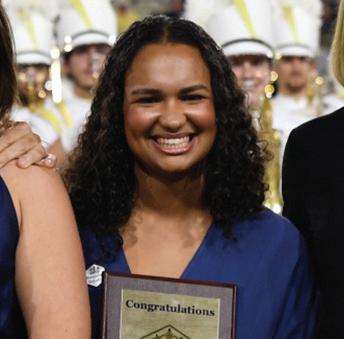


Tepolak Seth was one of four students selected as Commencement reflection speakers for Georgia Tech’s Fall Commencement ceremonies. In each of the four ceremonies (Ph.D., and three ceremonies combining bachelor’s and master’s degrees), a graduating student is given three minutes to deliver an inspiring message. Students must apply to become a reflection speaker. A panel of faculty, staff, and students selects a group of finalists who present a full version of their speech to the committee. Seth, who earned her master’s degree in civil engineering, was an international student from Phnom Penh, Cambodia. She now works in the Bay Area as a civil engineer with Tesla.
Fourth-year civil engineering student Aimee Ogando was selected as one of two 2023 Ramblin' Royalty honorees following a vote by Georgia Tech students. The Ramblin’ Royalty selection process begins with nominations from student organizations. The top candidates then participate in multiple interviews before being selected as a finalist. Ogando served as the president of the Society of Hispanic Professional Engineers. In addition she was an edge mentor and Challenge Counselor and served on the Undergraduate Student Advisory Council for Civil and Environmental Engineering. She was also involved around campus with the Office of Minority Educational Development, Hispanic Recruitment Team, SMILE, and the 2022 FASET Cabinet.
Ph.D. student Michael Thomas was selected for the 2023 Public Health Informatics Fellowship with the Centers for Disease Control and Prevention (CDC). During the two-year fellowship, Thomas will be working at the National Center for Immunization and Respiratory Diseases. Thomas will focus on data analysis and technology evaluation, specifically targeting infectious viral diseases. After an extensive interview process with 10 host sites, Thomas was matched with the CDC’s Division of Viral Diseases. The Division aims to prevent viral diseases through optimized vaccine usage and efficient outbreak responses.
Spenser Wipperfurth, a Ph.D. student in Ocean Science and Engineering, is one of five graduate students selected for the third class of the Brook Byers Institute for Sustainable Systems (BBISS) Graduate Fellows. The BBISS Graduate Fellows Program provides graduate students with enhanced training in sustainability, team science, and leadership in addition to their usual programs of study.
Three CEE Alumni were among a group of 30 College of Engineering graduates honored at the 2024 Alumni Awards Induction Ceremony in Atlanta. They were celebrated for their contributions to the engineering profession, career accomplishments, and the ways they’ve enhanced the lives of others both personally and professionally.
Read more about the three honorees who graduated from the School of Civil and Environmental Engineering:

Wassim A. Selman, CE 81, M.S. CE 82, Ph.D. CE 86
President, Mobility U.S. – Arcadis
Academy of Distinguished Engineering Alumni
Selman is a senior executive with Arcadis, a global planning and engineering consulting firm, and has provided transportation consulting services for 30 years. Selman has led the planning, design, and construction management of large transportation projects in highway, rail, and aviation throughout the United States. His experience includes mobility advisory, transportation system planning and design, multimodal corridor studies, and mobility management. He has led Arcadis’ U.S. transportation business for more than 10 years and is a member of the firm’s global mobility executive team. He previously directed technical knowledge and innovation, federal programs, and smart infrastructure solutions at Arcadis.
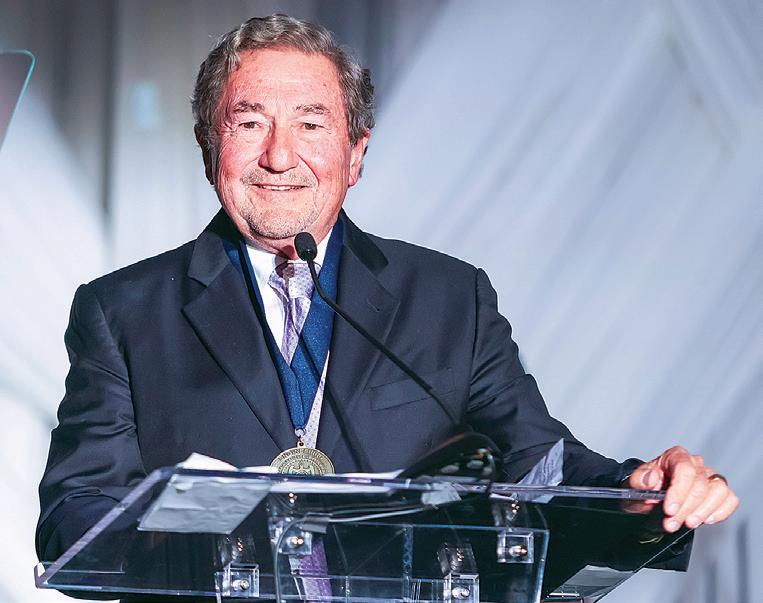
Andrew Miller, CE 09, M.S. CE 10, Ph.D. BIOE 17
Chief Operating Officer, restor3d, Inc.
Council of Outstanding Young Engineering Alumni
Miller co-founded the medical device startup restor3d, Inc., which set out to harness 3D printing to provide mass personalization and achieve improved outcomes in orthopedic procedures. As CEO, Miller helped restor3d grow rapidly by meeting unmet needs in the orthopedic implant market. As COO, Miller currently is focused on developing the internal processes and technology to broaden the company’s offerings and equip more surgeons with an enhanced ability to repair and reconstruct the human body. After a recent acquisition, the company now employs more than 300 people and is a market leader in personalized orthopedic implants.

Federico
Stubbe,
Chairman, PRISA Group Engineering Hall of Fame
Stubbe is the chairman of PRISA Group, a family-owned developer, builder, and operator of master-planned residential communities. The company also develops resort, hospitality, education, healthcare, gaming, and entertainment projects in Puerto Rico and Florida, employing more than 2,500 people. The firm has completed more than $2 billion in development projects during the last decade. This includes 11 hotels, seven residential projects, a $125 million community hospital, and Distrito T-Mobile, a $250 million state-of-the-art urban entertainment district.
Several young alumni were honored by the Georgia Section of the American Society of Civil Engineers at its Annual Awards Celebration on June 21:

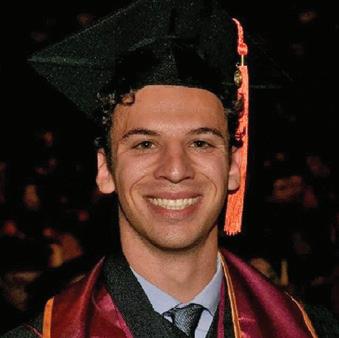
• Yona Rubin, MS CE 2024: President’s Award
Research Fellow, Extreme Loads on Structures Lab (ELSL) Technion - Israel Institute of Technology
• Clara Bailey, CE 24 Civil Engineering Student of The Year Award MS Student, Georgia Tech School of Civil and Environmental Engineering
• Erin Robinson, CE 22: Young Civil Engineer of The Year Award
Transportation Engineer III at Columbia Engineering

• Sam Dennard, CE 18: Volunteer of The Year Award
Transportation Engineer III at Columbia Engineering

The Georgia Tech Alumni Association’s 2024 Class of 40 Under 40 celebrates the inspiring work of Yellow Jackets around the globe. Honorees must have completed at least one semester at Georgia Tech and be under the age of 40 as of June 30, 2024.
Gul A. Amir, CE 13
Traffic Engineer III | Georgia Department of Transportation
Gul Amir is an entrepreneur and a highly efficient traffic engineer with the Georgia Department of Transportation. She has experience in signal operations, contract management, and Department of Transportation policies. Amir’s communication skills and ability to handle complex signal operation projects have allowed her to excel in this position. She is a passionate, certified substitute teacher and PTSA volunteer. Amir loves to give back to the community and sews weighted blankets for people in need.

On March 1, 2024, I marked one year of service at CEE as Director of Development. It has been an honor and a pleasure to get to know many of you and to raise support for this remarkable School, its students and its faculty.
FY2023-2024 was the second full year of the public phase of the Institute’s Transforming Tomorrow campaign. CEE made great progress towards our campaign goal of $50 million, raising $9,974,231 in new commitments. This was CEE’s best fundraising year for 5 years. The vast majority of these commitments were from alumni; corporations were the next most generous source of philanthropic support. Almost 90% of these new commitments went to new and existing endowments, reflecting our alumni’s and friends’ understanding of the importance of creating a stable base of support that will continue in perpetuity. Of this 90%, 31% was for endowed student support (scholarships and fellowships), and 68% was for endowed unrestricted support, giving the current and future school chairs the flexibility to meet unexpected challenges in the future. The remaining 1% of endowment giving supports faculty and programmatic endowments.
Due to your generosity and commitment, at of the close of FY2324, CEE raised $43,941,255 of the campaign goal of $50 Million, or 88% of goal. The Transforming Tomorrow campaign ends on December 31, 2027, and only the College of Engineering, Mechanical Engineering and Physics have surpassed their campaign goal at this early point. We are determined to make CEE next over the finish line, and poised to exceed all expectations by the end of the campaign.
A focus of the next few months will be the Graduate Student Endowment challenge. As many of you know, an anonymous donor has provided $5 million in matching funds to encourage CEE alumni and friends to establish endowments to recruit and retain the most talented PhD students in civil and environmental engineering. CEE lags far behind our peer institutions in dedicated endowment funding for PhD students. This poses a serious threat to our standing in the future. Increasing the School’s funding for graduate students is one of CEE’s primary campaign goals. Raising the $5 million in named endowments will enable CEE to take full advantage of this transformative matching opportunity.
Thank you to every single one of you who included CEE in your philanthropy this year.

Warm regards, and GO Jackets!
Patricia D. White Director of Development
By Joshua Stewart
After earning his bachelor’s and master’s degrees in civil engineering through the BS/MS Program this spring, Thomas Vandiver began his dream job in structural engineering and building design. It’s a much different future than seemed possible for Vandiver seven or eight years ago. And it may very well be because he refused — time and again — to give up or settle for the comfortable path.
Vandiver kept working. Kept putting himself out there. Kept overcoming obstacles.
After high school, Vandiver said he seemed to find trouble around every corner. He spiraled into substance abuse and had several run-ins with the law. For a while, he bounced around what he called dead-end jobs.
“I always kind of floated along through life thinking that I was going to make it big one day,” Vandiver said. “Something or somebody was going to come out of the blue and say, ‘Hey, we’ve been looking for you.’ Thinking I was going to stumble on to something great.”
At 27, Vandiver decided something needed to change. He checked into a rehabilitation program, and he started thinking about what came next. The pastor of a church connected with the program invited Vandiver to live with his family and pursue an education.
So he did, enrolling at West Georgia Technical College to work toward a vocational certificate. To help pay for school, he worked with a general contractor and even started a homebuilding and renovation business on the side.
He fell in love with learning, particularly enjoying his math courses, and wondered what he could do with that. When he saw the associate degree in engineering program, he thought that could be a good fit.
It was. And soon he was eyeing a transfer to the University of West Georgia to take more rigorous courses. Then he took advantage of the Regents Engineering Pathway Program to apply for another transfer — this time to Georgia Tech to study civil engineering.
For the last five years, Vandiver has commuted to Tech’s campus from Carrollton, spending three hours a day on the road fighting for his college dream. Balancing tough courses, working, and commuting meant he didn’t always get as much sleep as he wanted. But it’s been worth it: A structural engineering internship at Uzun + Case turned into a full-time job.
“Nothing good comes easy. I think Georgia Tech’s a testament of that,” Vandiver said. “It’s been stressful. It’s

caused me to scream at my computer thousands of times. It’s caused me to have panic attacks. But it’s been great. It’s been the most beautiful thing I’ve ever done.”
In his early days on campus, Vandiver said he sometimes felt like his age and the years he wasted set him apart from students who were younger and better prepared.
One of the places that helped was the College of Engineering’s Center for Engineering Education and Diversity (CEED), where he found a community he could connect with.
“CEED was such a good environment with so many good people to learn from, and a lot of them have come from their own big struggles. There was a shared camaraderie of knowing that someone else’s journey was just as rocky as mine,” Vandiver said.
“I feel like I was in a fog for so many years, and then, you know, to wake up one day and see so many great people around you, you just want to get to know them.”
Before long, he was involved in CEED’s Peer 2 Peer mentoring program. Now he’s a graduate mentor, helping guide a group of younger mentors and mentees.
In fact, Vandiver’s face has become a symbol of Georgia Tech’s transformational impact. His photo hangs on many of the light poles around campus promoting the Transforming Tomorrow campaign, and he’s appeared on an alumni mailer, too.
“I’m like, how did this happen? Then I learned about the campaign. And so, I want people to know that Georgia Tech transformed my tomorrow,” he said. “It was a lot worse, and I would like people to know that they made a difference.” l
By Sara Franc
Throughout her life, Mo Jarin, Ph.D. student in environmental engineering, visited her family’s home country of Bangladesh, where water quality issues are prevalent. This experience coupled with Jarin’s affinity toward research led her to the University of Buffalo for her undergrad.
Jarin was working with nanotechnology focusing on clean water, specifically as it relates to other places of the world. While Jarin’s bachelor’s degree was in chemical engineering, her research was in environmental engineering, and she felt this work was making realworld impact. She decided to continue her work with a graduate education in environmental engineering.
While Jarin received offers from prestigious universities across the country, her decision to attend Georgia Tech for her graduate education was significantly influenced by the people and opportunities it offered. She credits the students and staff she met during her visit to Tech as the impetus for her decision, specifically Danielle Lesperance Ramirez, a Graduate Programs Manager in the School of Civil and Environmental Engineering graduate school, and her advisor, Carlton S. Wilder Early Career Professor Xing Xie.
“My advisor is a very open, welcoming individual,” said Jarin. “Despite his extremely nice exterior, he pushed very hard for me to come here. He nominated me for the President’s Fellowship that I received. He clearly showed that not only did he want to advise me and guide me, but he also showed me the potential I didn’t see in myself. That is how I ended up here, and I have never regretted it since.”
Xie’s support fostered a transformative experience in her research journey.
“He first pushed me into some of these entrepreneurial paths,” said Jarin. “It really brought out all of my strengths, and now I’m getting to do cutting-edge research. I don’t think I would have had the slightest fraction of a similar experience anywhere else.”
Jarin’s dedication and accomplishments have garnered recognition, including winning prestigious awards. Most recently, Jarin’s research titled, “Operando investigation of the synergistic effect of electric field treatment and copper for bacteria inactivation,” was published in Nature Communications
Pioneering Safer Water Disinfection
At the forefront of her laboratory’s efforts to develop alternative water disinfection technologies, Jarin’s work offers promising solutions to mitigate the risks associated with traditional chlorine-based treatments.
Her lab’s innovative approach, Locally Enhanced Electric Field Treatment (LEEFT), harnesses the power of enhanced electric fields and copper ions to eliminate waterborne pathogens without relying on chlorine.

Through meticulous observation, Jarin uncovered crucial insights into LEEFT’s mechanisms when combined with copper. The research published in Nature Communications focused on understanding this mechanism in ways we can’t observe with the naked eye.
“What we found is that the electric field will weaken the membranes of these potential pathogens, allowing copper to have a much stronger and faster effect in killing them,” said Jarin.
Beyond the laboratory, Jarin envisions practical applications for LEEFT in environments like swimming pools and hot tubs, where reducing chlorine reliance can minimize health and environmental risks.
Looking ahead, Jarin is committed to advancing her research and realizing the potential of the LEEFT technology. Her end goal is to retrofit LEEFT like a smart pipe into the water distribution pipelines, so that it can provide antimicrobial power over the entire distribution system.
“We’re years away, but we’re getting close to an applicable prototype,” said Jarin. “We need a lot of upgrading of our water infrastructure, especially in the U.S., and it can also be very impactful to the rest of the world.”
As she marches forward towards her goal of implementing LEEFT technology into water distribution systems, Jarin's impact extends far beyond the laboratory, promising a safer and healthier tomorrow for communities everywhere.
Jarin was awarded a spot in a seven-week boot camp through the entrepreneurial-focused U.S. National Science Foundation’s Innovation Corps program (NSF I-Corps).
The NSF I-Corps program prepares participants to extend their focus beyond the university laboratory and translate it to the marketplace. Entrepreneurship is a non-traditional career path for researchers, but Jarin wanted to explore the transformation of invention to impact with her lab’s pioneering water disinfection technology.
“It was the most challenging thing I have ever done,” said Jarin. “I have worked tremendously hard over the last several
Continues on next page

years, but that was still the most challenging experience I have had.”
NSF I-Corps participants are supposed to work in teams of three, but amidst the backdrop of a global pandemic in 2021, Jarin navigated the program largely solo. This included conducting over 100 interviews with industry experts and potential consumers all over the country, with the goal of figuring out where her technology could have the most value and impact.
Conducting these interviews alone made the program tremendously difficult, but a key aspect of this program is that participants must fail.
“They want you to fail — they push you until you fail,” said Jarin. “In startups, the more failures you have, the closer you’re getting to success.”
At one point throughout the process, Jarin realized that the market she was focusing on was not going to work out.
“I needed to do a full pivot, and that was the real low,” said Jarin. “It was one of the lowest points of my doctoral degree dealing with failure over and over again in this program.”
Embracing Growth in the Face of Failure
Thinking back on that time, Jarin can see how much the program pushed her to grow.
“The program itself drained me, but the takeaways lasted for years,” said Jarin. “I didn’t know them at the time, but I realized I am more open to failure, more open to pivoting, more open to feedback, criticism, ability to pitch, interview, speak with strangers, present — everything had been opened up so that my growth opportunity was tremendously larger.”
This experience allowed Jarin to make the most out of her entrepreneurial and doctoral journey. She continues to demonstrate her willingness to take risks and face
To help fund permanent graduate endowments that will enable CEE to recruit the best graduate students, contact Patricia White, CEE Director of Development at patricia.white@ce.gatech.edu or Gloria Lin, CEE Development Associate at gloria.lin@ce.gatech.edu.
new challenges during her time at Tech.
Jarin has gone on to win the CEE Entrepreneurial Impact Prize, CRIDC Innovation Competition, Georgia Research Alliance Phase I Grant, and NSF Partnerships for Innovation Award. She was also part of the inaugural Female Founders cohort at Tech, a CREATE-X initiative to “provide a space for female-led entrepreneurial teams to explore a first business model, engage with an all-female coaching team, interact with successful female entrepreneurs, and receive non-dilutive funding.”
The Next Chapter
Between the research and competitions and expos and mentorship, Jarin admits that she has not come to find balance in her doctoral program easily.
“I don’t want to be one of those people that says, ‘I’ve got everything under control,’” said Jarin. “I think it’s best to be honest and say that we’re all struggling. I think as long as you have interest in what you’re doing, I think you can find a sense of well-being.”
Now in her fourth year at Tech, Jarin is keeping an open mind for her future.
“I just got accepted as a Future Faculty Fellow in the School of Civil and Environmental Engineering, so I’ll get the opportunity to work with different mentors and in coordination with the Tech to Teaching program,” said Jarin.
Through Jarin’s experience teaching, she has discovered that she likes working with students. She sees herself pursuing an academic role around leadership, innovation, and entrepreneurship in the future.
“I enjoy breaking all of the constructs that have been built before me,” said Jarin. “I want to break what a traditional Ph.D. looks like.” l
Perez-Guzman's interest lies in addressing problems within supply chain and transportation domains. These challenges often encompass disruptions, human behavior, multiple stakeholders, and equity and sustainability objectives.

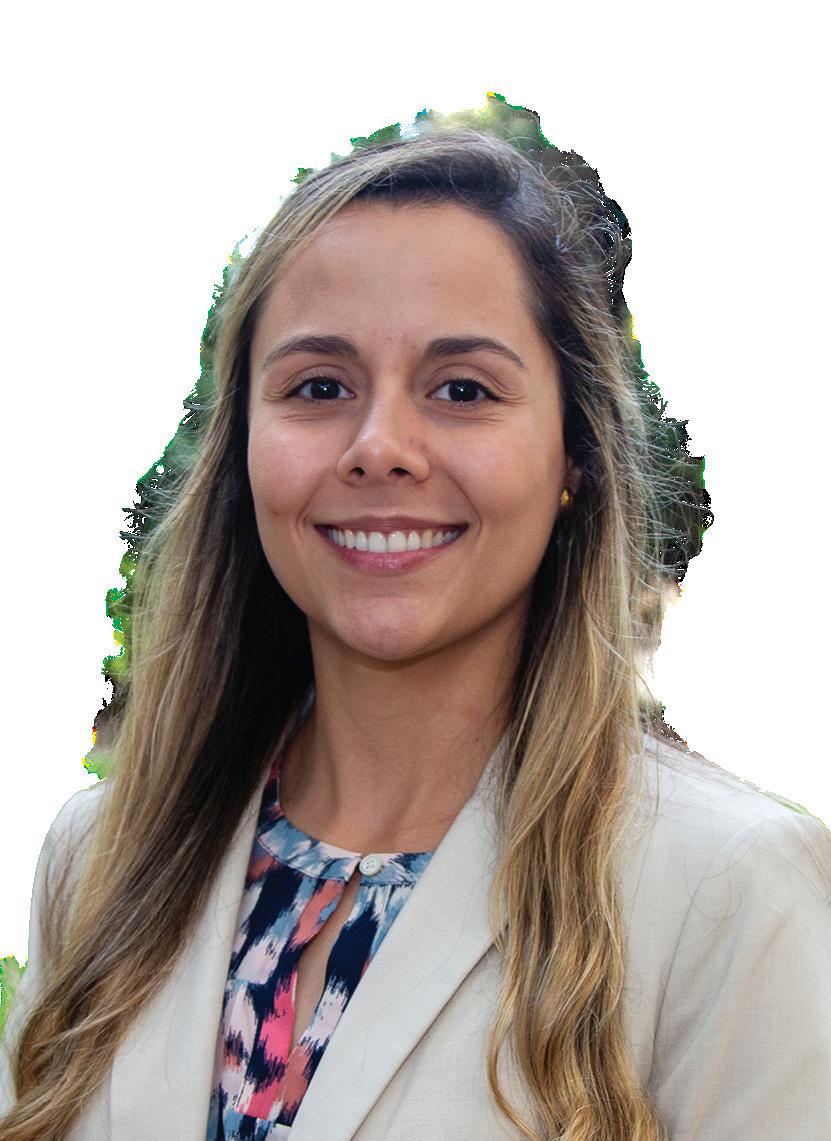
Smyl’s research focuses on developing tools to better design, understand, monitor and characterize life cycle processes of structures and materials.
Snyder’s research focuses on environmental sustainability under climate change scenarios. He specializes in water recycling for municipal and industrial purposes, and leads projects in the areas of waste material upcycling and resource recovery.

The School of Civil and Environmental Engineering has selected five faculty members for endowed faculty chairs and professorships, including four new endowed positions introduced this year.
Endowed professorships and faculty chairs recognize faculty who stretch the boundaries of their disciplines. In addition to prestige, professorships provide faculty members with discretionary funding for research, equipment, travel and other professional development to advance their work. CEE has more than tripled its number of endowed professorships and faculty chairs since 2018, thanks to generous gifts from alumni and friends of the School.
Sheng Dai has been appointed as the inaugural holder of the Georgia Mining Association Early Career Professorship. Dai’s research expertise is in geotechnical engineering with a focus on energy issues. He is known for studying geomaterials under elevated temperature and pressure conditions. the Georgia Mining Association Early Career Professorship was endowed by the Georgia Mining Association, a trade association founded in 1972 to advance and encourage the mineral resource industries of the State of Georgia.


Jennifer Kaiser has been appointed to the Clifford and William Greene, Jr. Early Career Professorship. Her research expertise is in atmospheric chemistry and air quality engineering, focusing particularly on the emissions, formation, and impacts of air pollutants. The Greene endowment was established in 2019 by Paul R. Greene in memory of his parents, Clifford and William J. Greene Jr., CE 36.
Aris Georgakakos has been appointed the Turnipseed Family Professor. He has served since 1998 as the Director of the Georgia Water Resources Institute. Georgakakos has been a prolific researcher and has made significant scholarly contributions. Dr. Georgakakos’ expertise is in the area of water resources management and hydrology. The Turnipseed Family chair was endowed by Ben Turnipseed, CE 69, and his family, who have deep connections to CEE and the Institute. Turnipseed served on the CEE External Advisory Board and was inducted into the College of Engineering Hall of Fame in 2019 and to the College of Engineering Academy of Distinguished Engineering Alumni in 2002 in recognition of his career accomplishments.


Sotira Yiacoumi has been appointed to the Susan G. and Christopher D. Pappas Professorship. Her research interests include colloidal and interfacial phenomena in environmental and energy systems. Her research contributions span the following areas: sorption phenomena, colloidal phenomena, influence of sorption on colloidal behavior, molecular techniques, and novel environmental processes. The Pappas professorship was founded in 2016 by Susan and Christopher Pappas, both CE 78, to support the work of faculty in the School.
Shane Snyder has been named the inaugural holder of the José Domingo Pérez Foundation Chair. His research focuses on water quality, treatment, and sustainability, which resulted in over 300 published manuscripts with over 37,000 citations. Snyder is a Fellow of the International Water Association and a Board-Certified Environmental Scientist (BCES) by Eminence from the American Academy of Engineers and Scientists.The José Domingo Pérez Foundation Chair was endowed by a generous gift from José Domingo Pérez, CE 71.


International student travel grew in popularity in the 2023-24 academic year. Our students utilized Mundy Funds to travel across the world to explore and gain new cultural perspectives. Students traveled to The Netherlands, Chile, Antartica, Australia, and across Europe. The Joe S. Mundy Global Learning Endowment provides financial support for CEE students to travel for the purpose of cross-cultural development.
Clockwise from top left: 1) A bridge over a canal in Amsterdam at night; 2) Kathryn Owusu at the Acropolis in Athens; 3) Mark Rotolo at the world-famous Sydney Opera House.


2

Clockwise from top left:1) Adrian Tirouvanziam standing in front of El Alto de Los Leones; 2) Taylor Sherwood kayaking at Astrolabe Island; 3) Hannah Shin exploring Paris; 4) Crazy creatures Mark Rotolo encountered Down Under while scuba diving; 5) Class selfie after Gutenberg Museum visit in Mainz, Germany.
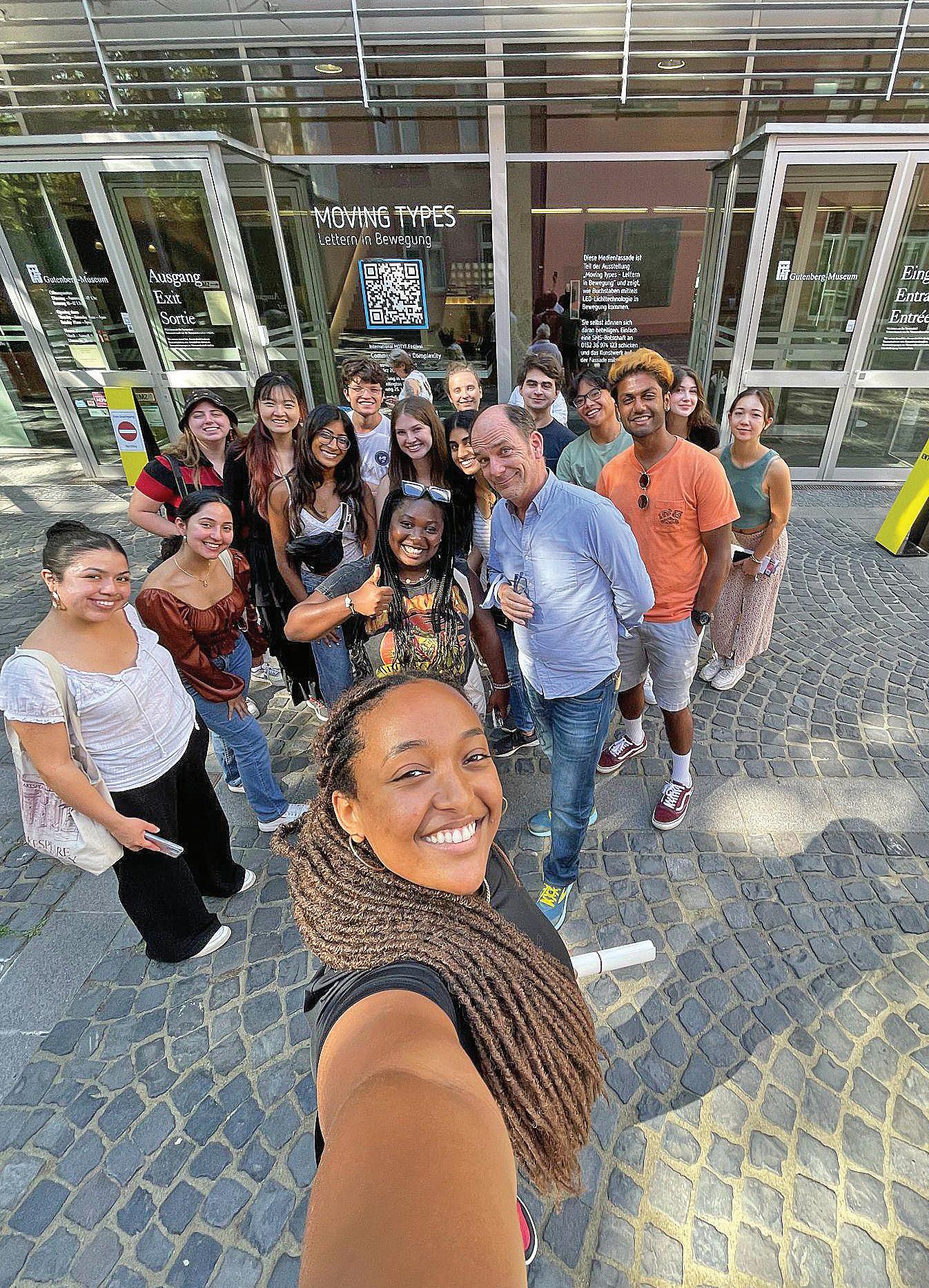




PHOTO BY AMELIA NEUMEISTER
KENNETH
HYATT DISTINGUISHED LEADERSHIP SPEAKER FALL 2023
Civil and environmental engineering is the base for this tower of knowledge… We develop other skills that bridge us across to different areas.
– Jose Bern ”
By Melissa Fralick
Over the course of his career, Jose Bern has done many things he never would have expected as a shy civil engineering student: public speaking, sales, and even dancing in a flash mob.
Bern, CE 95, spoke to students during the Fall 2023 Hyatt Lecture on Oct. 19 about the importance of branching out and learning new skills to achieve success over the course of their careers.
Bern is the corporate vice president of Empresas Bern, where he leads the sales and development division. In the last 45 years, the company has built the skyline of Panama with over 170 corporate, retail and residential projects.
Despite his background in civil engineering, Bern told students that as he has advanced in his career, most of what he does revolves around management and sales.
“Civil and environmental engineering is the base for this tower of knowledge…We develop other skills that bridge us across to different areas,” Bern said. “Nowadays, I use more of my people skills every day than my math skills.”
Bern recalled two things that really helped him develop those people skills he now uses so often in leadership.
Shortly before arriving at Georgia Tech, he read "How to Win Friends and Influence People" by Dale Carnegie. This classic book of business wisdom had a significant impact on his views regarding leadership and human interaction.
He noted that a psychology class he took as an elective while he was a student at Tech changed his understanding of human behavior and motivation. He recommended that students take psychology if they have the opportunity.
“It gives you a perspective on how a different system works—the human system,” Bern said.
Bern told students that the real world often presents challenges where they will need to balance their knowledge of the human system with their engineering expertise and problems-solving skills.
He provided as an example, the issue of providing enough drinking water to the population of Panama.
“We have a solution, we’ve had it for 20 years,” Bern said. “The U.S. Corps of Engineers recommends we flood the Rio Indio and engineering-wise it’s a perfect solution. Politically, it’s an issue because you’re going to flood a bunch of people’s homes and their farmlands.”
“So even though engineering-wise we know what to do, the implementation is not so simple. We have to negotiate our way around.”
Bern stressed the importance of empathy and the duty of engineer-leaders to look after their teams and the people their work impacts. He left students with the message that their journey extends beyond the technical aspects of their field, encompassing the broader landscape of human interactions and leadership. l
Empower people and give them confidence and they will do great things.
– Jean-Lou Chameau ” “

By Melissa Fralick
Throughout his career, Jean-Lou Chameau has left a positive impact at top universities around the world with his unique brand of engineering leadership.
Chameau returned to Georgia Tech on March 5 for the Spring 2024 Hyatt Lecture to share stories from his life in Leadership. Chameau arrived at Tech in 1991 to serve as chair of the School of Civil and Environmental Engineering and went on to become provost of the Institute.
After leaving Tech, Chameau became president of the California Institute of Technology. He was later recruited to become the president of King Abdullah University of Science and Technology in Saudi Arabia.
For the first time since the Hyatt Distinguished Leadership Lecture Series was established in 2015, the lecture was delivered in the form of a fireside chat.
Chameau was joined by Georgia Tech President Emeritus G. Wayne Clough, who asked him a series of insightful questions about his life. They share a special connection dating back to the beginning of their careers: Clough was Chameau’s PhD advisor as a young faculty member at Stanford University.
The theme of Chameau’s lecture was leadership from the ground up, emphasizing his humble background and dedication to serving others.
Chameau’s journey to civil engineering began in his native France, where he was the first in his family to go to college. He credits his grandmother for providing a strong foundation in life and instilling in him the values of humility, respect, and hard work.
While working toward his engineering degree in France, He met a visiting scholar from the U.S. with a PhD in engineering. Intrigued by the possibility of earning a graduate degree abroad, he began researching and applying to engineering programs in America. He was accepted to Stanford, which caught his eye not only for its academics but its proximity to the culture-capital of San Francisco.
“It was the time of the mid-70s, it was still the time of the hippies and San Francisco was the place to go,” Chameau said.
Though he didn’t care for his geotechnical engineering course in France, Chameau decided to give it another shot at Stanford. He enrolled in a class taught by Clough that completely changed his view. Chameau loved the subject and went on to work with Clough as his PhD advisor.
Continues on next page
KENNETH HYATT DISTINGUISHED LEADERSHIP SPEAKER SPRING 2024
“Having a student like Jean-Lou was really a pleasure,” Clough said. “My job was really not to do anything to hold him back.”
After earning his PhD, Chameau was hired to join the faculty at Purdue University. It wasn’t long before he was offered his first leadership position.
Chameau worked with seven other faculty members in the geosystems engineering group. They were all accomplished scholars individually, but they didn’t get along well and argued often.
Shortly after being promoted to associate professor, Chameau was asked by his department chair to lead the geotechnical group.
“You seem to be the only one they are able to talk to and work with,” he recalled his department chair telling him.
Chameau found that he really enjoyed his newfound role leading and supporting his colleagues, rather than focusing only on his own success.
He told students to pursue leadership if they find it fulfilling.
“You will have opportunities to be in a leadership position. But something I really encourage you to pay attention to: Do it if you really feel rewarded by it in terms of serving, because you will be serving those people,” Chameau said. “You have to be willing to serve and care about people and make it your priority compared to your own priorities.”
When Chameau arrived at Georgia Tech, it was not yet a nationally ranked civil engineering program. But Chameau recognized the potential within the School. There were many young faculty members with great ideas, but they didn’t have the resources or institutional support to accomplish them.
Chameau told the faculty he wanted to support their ideas and figure out how to make them happen.
“Empower people and give them confidence and they will do great things,” Chameau said.
Chameau briefly left academia to work in private industry. When Clough became president of Georgia Tech, he invited Chameau to join his leadership team.
“I wanted to create a whole new way of looking at research and graduate studies. I knew I needed somebody who had an innovative outlook on life,” Clough said. “He came back and made a huge difference in my administration.”
Chameau recalled the excitement of working with the team Clough assembled at the start of his tenure as president.
“The team to me is the most important thing you do as a leader initially,” Chameau said. “There was a great team of people who really felt we have a great opportunity to transform this place into one of the best in the world under the leadership of Wayne and his vision.”
In 2006, Chameau moved across the country to become president of Caltech.
Not long into his tenure, Chameau faced the challenges of the Great Recession. It was a difficult time to be in a position of institutional leadership and Chameau had to make tough decisions, implementing budget cuts while keeping an eye on the future.

” “
You
will have opportunities to be in a leadership position. But something I really encourage you to pay attention to: Do it if you really feel rewarded by it in terms of serving, because you will be serving those people.
— Jean-Lou Chameau
“We were the only university in California, and maybe the U.S., that kept hiring during that time,” Chameau said.
He urged students to be prepared for both the good and the bad times that they may experience as a leader.
After serving as president of Caltech for seven years, Chameau received an opportunity to move abroad and lead a new university in Saudi Arabia called King Abdullah University of Science and Technology (KAUST). The university, established in 2009, allowed men and women to study together for the first time in the nation’s history.
Chameau was enjoying his work at Caltech, and was planning to stay in his role for 2-3 more years before considering a move.
“I don’t believe you should be in a leadership position for too long,” Chameau said.
Though it came earlier than he was expecting, Chameau was drawn to the opportunity.
“It was hard to say no when you realize you can do something that is very important for a particular country, but a country also that is important to the world, and to a society where you can be a wedge for change,” Chameau said.
He said despite his many successes, the work of a leader is difficult.
“There are many times where it’s hard and times where you feel it’s impossible. There were times I didn’t sleep at night,” Chameau said. “Remain focused on what your role is and always think about ultimately what counts is the people in front of you.” l
OUR 2024-2025 SPEAKERS
FALL 2024

Gretchen Goldman, MS EnvE 08, Ph.D. EnvE 11
Climate Change Research and Technology Director at the U.S. Department of Transportation, Co-director DOT Climate Change Center October 17, 2024
SPRING 2025
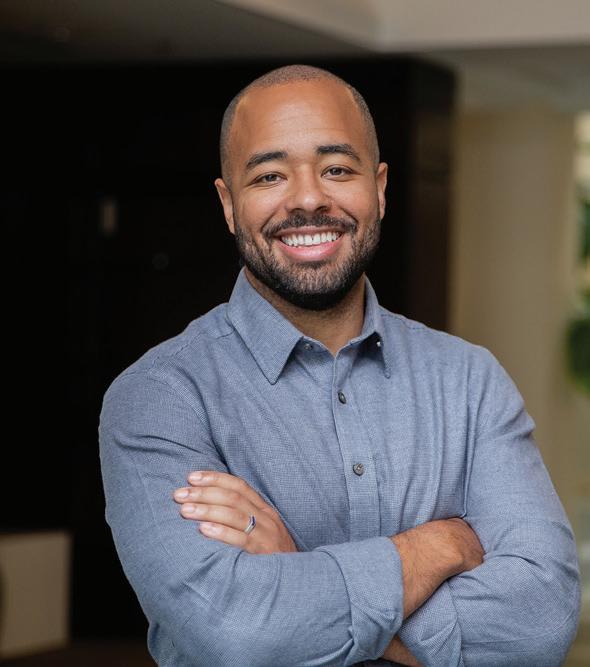
Jacob Tzegaegbe, CE 11, MS CE 13
VP Global Strategy, ADI Global Distribution February 13, 2025
The Hyatt Distinguished Leadership Speaker Series brings distinguished leaders to campus each fall and spring to share wisdom and insight with the School’s students and the wider Georgia Tech community.
It is made possible by the generous support of Kenneth Hyatt, CE 62, MS IM 66.
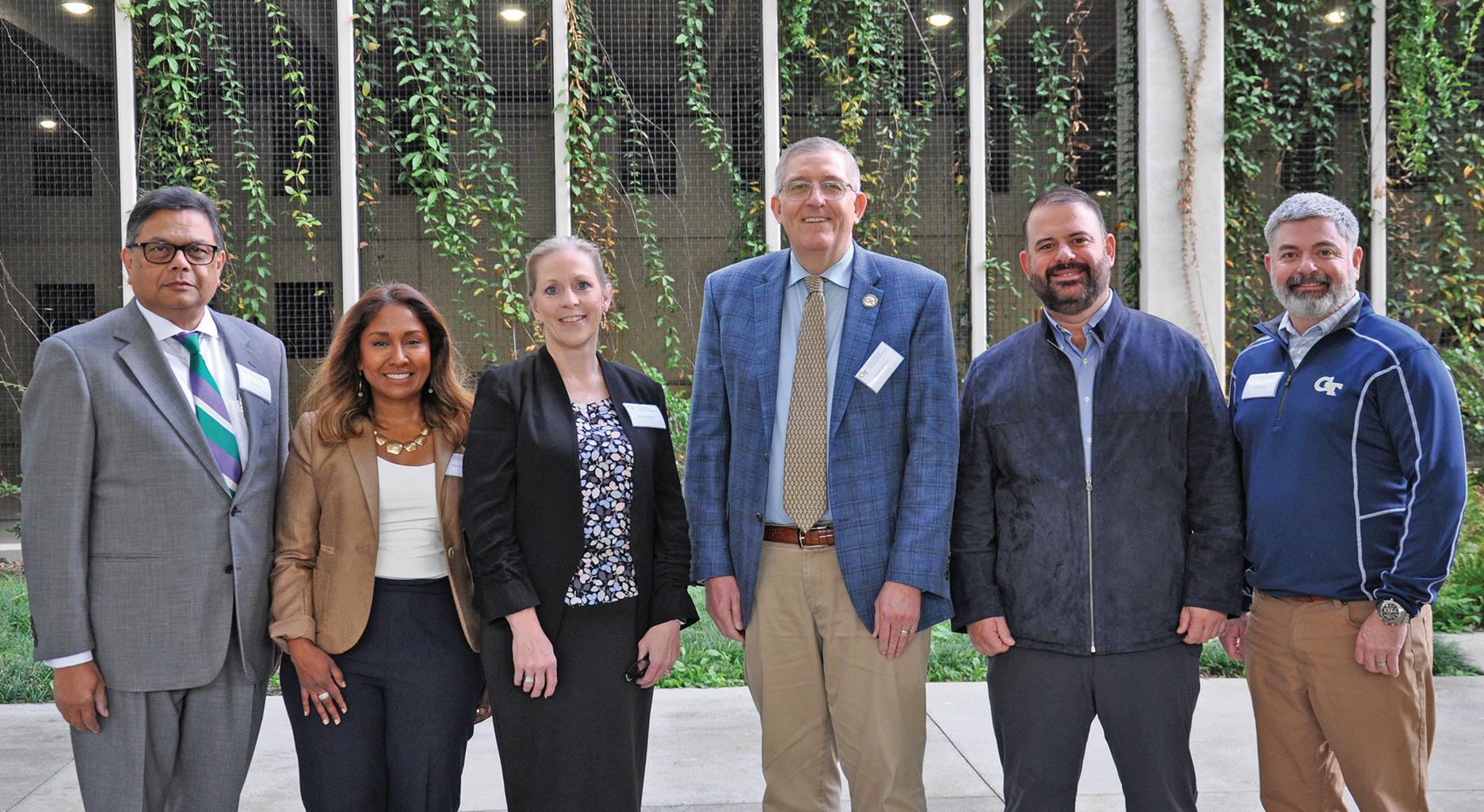
Five alumni began their three-year terms on the School's External Advisory Board. We are pleased to welcome:
• Anita Atkinson, CE 00 | Vice President of Engineering & Surveying, Patterson & Dewar Engineers
• Chris Brazell, CE 01, MS CE 04 | Chief Operations Officer, EMC Engineering Services, Inc.
• Eli Diaz-Atienza, CE 99 | Senior Vice President, TRC Services
• Bijoy Ghosh, MS ENVE 87 | VP & GM, Jacobs Southeast USA & Latin America Geography
• Kimberlie Staheli, PhD CE 06 | President, CEO, Staheli Trenchless Consultants
Your support provides vital resources that allow us to lead new initiatives, weather cyclical changes in government support, and make longterm investments in programs and technologies. Your gift can be directed to CEE students, faculty, and facilities in a variety ways, depending on your interest. Please contact us to discuss what you would like to achieve by partnering with us.
patricia.white@ce.gatech.edu P / 404.894.7289
Anita Atkinson
Vice President of Engineering & Surveying
Patterson & Dewar Engineers CE 2000
Carlyle Bernard Advisory Board Vice Chair Founder/President, St. Martin Consulting LLC CE 86, MS CE 94
Marty Boyd President, Carter & Sloope CE 94, MS CE 97
Chris Brazell
Chief Operations Officer
EMC Engineering Services, Inc. CE 01, MS CE 04
Fred Carlson
Project Development Manager, Alliance Exchange FL CE 01, MBA 04
Christy Darden
Director Engineering, Fleet, and Sustainable Operations, Forest Service, Pacific Northwest Region CE 92
Raul Delgado
Founder and CEO, CESEL Engineers CE 66, MS CE 68
Eli Diaz-Atienza
Senior Vice President TRC Services CE 99
Darion Dunn
Managing Partner, Atlantica Properties CE 01
Andrea Hence Evans
Owner/Attorney
The Law Firm of Andrea Hence Evans CE 99
Bijoy Ghosh
President
Infrastructure Consultants, LLC MS EnvE 87
Lorraine Green
Retired President, Pond & Company ChE 84, MS EnvE 93
Murray Griffin Chairman,
Atlantic Coast Consulting, Inc. CE 79
Frank Evan Haren Jr. President and CEO, Haren Construction Co. Inc. CE 77
Alvin James Jr. Vice President, Kimley-Horn & Associates, Inc. CE 01, MS CE 04
Cayman James
Project Manager, Jacobs Engineering Group CE 99, MS EnvE 01
Karen Jenkins Advisory Board Chair Managing Partner, Shear Structural M Arch 92, MS CE 93
Brian Lu
Founding Partner, The Leaven Group CE 99
Larry McDowell
Senior Principal, Uzun+Case, LLC CE 76
Michael Montgomery Retired CE 70, MS CE 76
Rebecca Nease
Retired Branch Chief, U.S. Nuclear Regulatory Commission CE 79
Guiomar Obregón
CEO & Founder, Precision 2000, Inc. MS CE 93, MS MGT 94
CEEatGT External Advisory Board Members provide an important outside perspective on our programs that is essential to maintaining their relevance to industry. They play a significant role in vetting programs designed for students, alumni and corporate constituencies to ensure we maintain the highest quality standards in our curriculum, practice and outreach.
Jacqueline Quinn NASA-KSC Liaison, NASA Kennedy Space Center CE 89
Zakiya Seymour
Business Advisory Practice Director, Arcadis MS EnvE 13, Ph.D. EnvE 13
Barbara Sloan
Retired Principal, Cambridge Systematics, Inc. MS CE 77
Kimberlie Staheli President, CEO Staheli Trenchless Consultants PhD CE 06
Knox W. Tull Jr. President, Jackson and Tull MS CE 72
Clifford Wang
Senior Vice President, RBC Wealth Management CE 94, MS CE 97
H. Arthur Williams President, Williams Steel Erection Company, Inc. CE 83
Amanda Atkinson
VP of Sustainable Services
Holder Construction
BC 02
Justis Brogan
Senior VP
McCarthy ME 04
Russ Brockelbank
VP Operations
Balfour Beatty Construction US CE 82
Paul Carter
Senior Vice President
Archer Western
Brent Cash
VP/Division Manager
Brasfield & Gorrie
CE 12
Robert Chambers
Partner
Smith Currie
Tom Gambino
Founder
Prime Engineering
CE 79
Kate Henry
Vice President
Aulick Engineering
CE 08
Dan Lemieux
Principal and Director
WJE
BSAR 88
Jimmy Mitchell
Board Chair
Sustainability Manager
Skanska USA
CE 05
Blake Peck Founder
Mcdonough Bolyard Peck, Inc.
CE 78
Brent Reid
President & CEO
Winter Companies CE 82
Josh Rowan
VP of Safety Technology
Applied Information, Inc.
CE 96
The Construction and Infrastructure Systems Engineering (CISE) Board provides guidance to administrators, faculty and students on the current needs of the construction industry. Members of this board also aid the School through industry networking, student curriculum, and advances in technology and innovation in construction engineering and management education at Georgia Tech.
Robyn Schoch
Senior VP of Construction
TriBridge Construction
Fred Tull VP J.E. Dunn BC 04
Dwayne Tedder
Traffic Practice Leader
Jacobs CE 00
Ed Yanacek
Project Executive
Clark Construction
CE 07
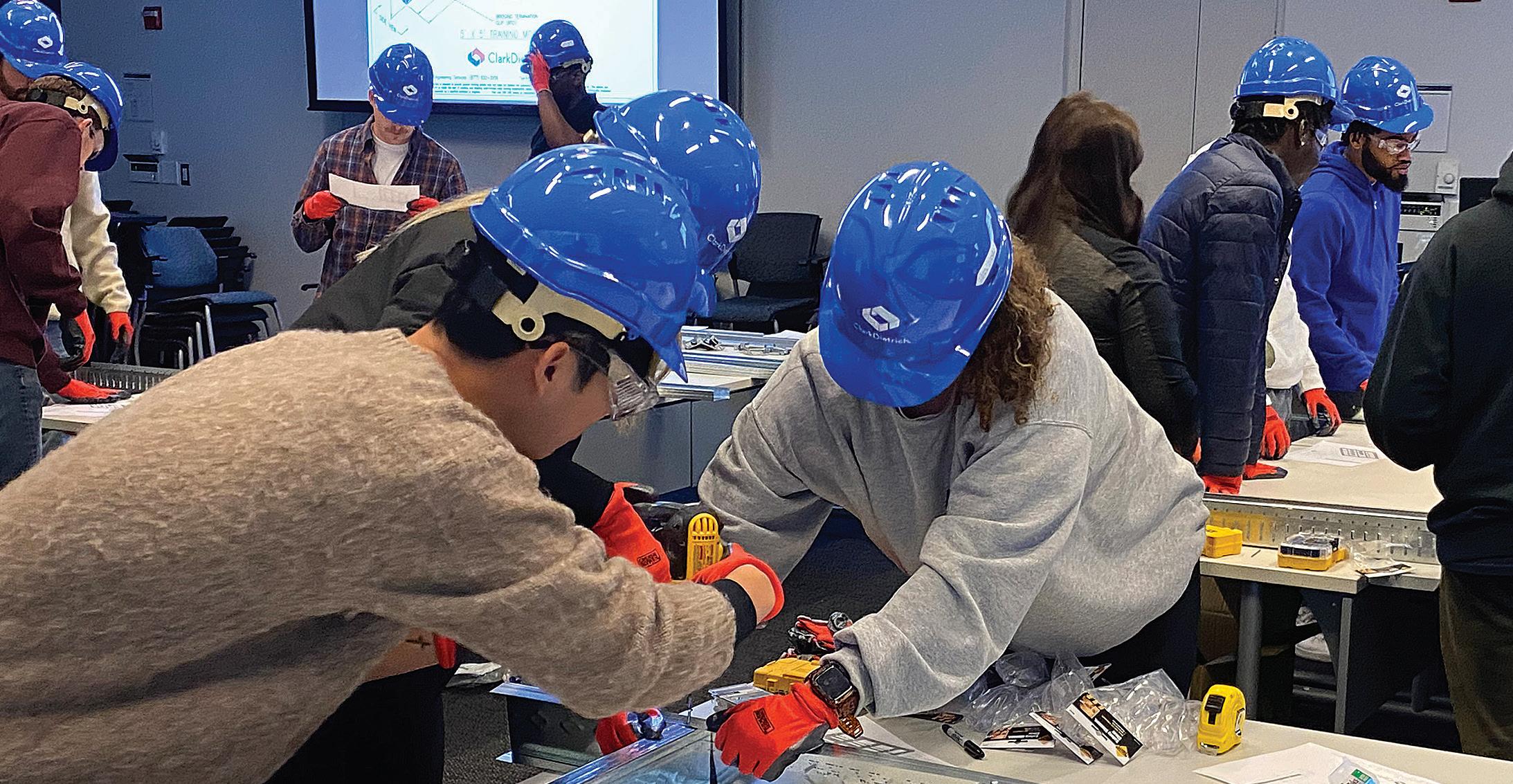
The goal of our Corporate Affiliates Program is to provide meaningful engagement to industry partners with the School of Civil and Environmental Engineering. Engagement opportunities extend past the standard career fair to give industry partners year-round access to our program and opportunities to build recognition and targeted relationships with our students. Companies also give valuable insight into the practice of being a civil or environmental engineer.
The goal of our Corporate Affiliates Program is to provide meaningful engagement to industry partners with the School of Civil and Environmental Engineering. Engagement opportunities extend past the standard career fair to give industry partners year-round access to our program and opportunities to build recognition and targeted relationships with our students. Companies also give valuable insight into the practice of being a civil or environmental engineer.
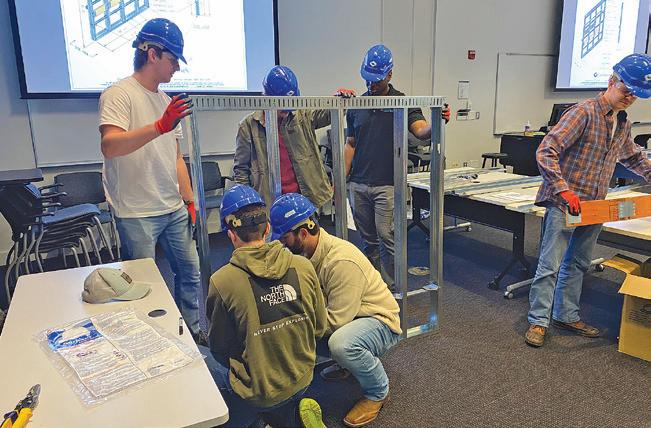




The program features a diverse set of activities that make it easy for organizations to engage with our students. Our tiered structure allows for companies of all sizes and civil disciplines to engage.
The program features a diverse set of activities that make it easy for organizations to engage with our students. Our tiered structure allows for companies of all sizes and civil disciples to engage.
·Free registration to CEE’s Fall Career Expo
·Access to student resumes
·FreeregistrationtoCEE’sFallCareerExpo
·Invitation to present in a class




·Accesstostudentresumes
·Invitationtopresentinaclass
·Host Day-in-the-Lobby events twice a year
·HostDay-in-the-Lobbyeventstwiceayear
·Host company information sessions twice a year
·Facilitate a skills-based or career workshop
·Hostcompanyinformationsessionstwiceayear
·Participation in GOLD Mentoring Program
·Facilityaskills-basedorcareerworkshop
·ParticipationinGOLDMentoringProgram
·Specialized postings for jobs and internships
·Company information listed on CEE website
·Specializedpostingsforjobsandinternships
·Join school sponsored events with students, and faculty
·CompanyinformationlistedonCEEwebsite
·Participate in Day-in-the-Office program
·Joinschoolsponsoredeventswithstudents,andfaculty
·ParticipateinDay-in-the-Officeprogram
All benefits included in White Tier plus:
AllbenefitsincludedinWhiteTierplus:
·Contribution to CAP undergraduate student scholarship
·Annual updates on scholarship recipient
·ContributiontoCAPundergraduatestudentscholarship
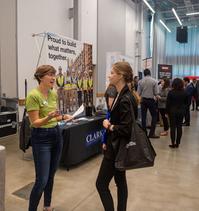
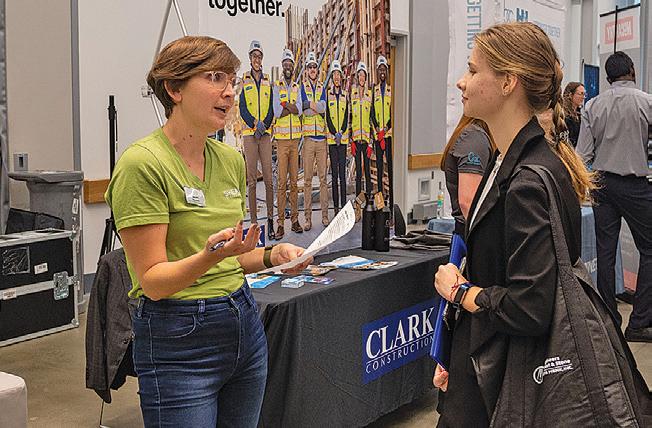

·Annualupdatesonscholarshiprecipient
·Invitation to scholarship luncheon to meet scholarship recipient
·Annual 1:1 meeting with School Chair
·Invitationtoscholarshipluncheontomeetscholarshiprecipient
·Annual1:1meetingwithSchoolChair
·Invitation to CEE’s Annual Alumni Homecoming Tailgate
·Invitation to sponsor an alumni event
·InvitationtoCEE’sAnnualAlumniHomecomingTailgate
·Invitationtosponsoranalumnievent
Interested in joining our Corporate Affiliates Program? Visit